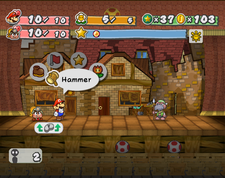Paper Mario (series): Difference between revisions
mNo edit summary |
(Undo revision 4175262 by 47.202.16.171 (talk) "Super Mario" is the official name of the franchise) Tags: Undo Mobile edit Advanced mobile edit |
||
| (595 intermediate revisions by more than 100 users not shown) | |||
| Line 1: | Line 1: | ||
{{italic title | {{italic title}} | ||
{{series | {{series infobox | ||
|image=[[File:Paper Mario Series Logo.png|300px]]<br>The logo used since ''[[Paper Mario: Color Splash]]'' | |||
|image=[[File: | |first=''[[Paper Mario]]'' ([[List of games by date#2000|2000]]) | ||
|first=''[[Paper Mario]]'' ([[List of | |latest=''[[Paper Mario: The Origami King]]'' ([[List of games by date#2020|2020]]) | ||
|latest=''[[Paper Mario: | |number=7 (6 direct, 1 upcoming remake) | ||
|number= | |franchise=''[[Super Mario (franchise)|Super Mario]]'' | ||
| | |staff=[[Ryota Kawade]] (2000–2007)<br> [[Shigeru Miyamoto]] (2000–2004)<br> [[Kensuke Tanabe]] (2007–present)<br>[[Naohiko Aoyama]] (2012–present)<br>[[Taro Kudo]] (2012–present)<br>[[Masahiko Nagaya]] (2016–present) | ||
}} | }} | ||
The '''''Paper Mario'' | The '''''Paper Mario''''' series is a [[Genre#Role-playing games|role-playing]] and action-adventure spinoff series of the [[Super Mario (franchise)|''Super Mario'' franchise]], developed for [[Nintendo]] by affiliate company [[Intelligent Systems]]. The series is named after its distinctive visual style, which consists of 2D paper {{wp|Cutout animation|cutout}} characters in 3D {{wp|papercraft}} environments. It is a {{wp|spiritual successor}} to ''[[Super Mario RPG: Legend of the Seven Stars]]'', the first RPG game in the ''Super Mario'' franchise, and follows many conventions established in that game. The first installment in the ''Paper Mario'' series, also called ''[[Paper Mario]]'', was released on [[Nintendo 64]] in 2000, and five further entries have since followed (four for home consoles and one handheld entry), as well as one remake. The series has also crossed over with fellow ''Super Mario'' RPG series ''[[Mario & Luigi (series)|Mario & Luigi]]'' with the game ''[[Mario & Luigi: Paper Jam]]''. | ||
== | ==Background== | ||
{| | During the {{wp|fifth generation of video games}}, {{wp|Sony Interactive Entertainment}}'s original {{wp|PlayStation (console)|PlayStation}} console overtook Nintendo's long-standing dominance in the home console market, resulting in the latter company's own console from that generation, the [[Nintendo 64]], being relegated to a distant second place. Nintendo's downfall during that era can be attributed to multiple decisions and strategies made by the company during this generation, namely launching the N64 in North America a full year behind the PlayStation,<ref name="Schilling">Schilling, Melissa A. “Technological Leapfrogging: LESSONS FROM THE U.S. VIDEO GAME CONSOLE INDUSTRY.” California Management Review, vol. 45, no. 3, Spring 2003, pp. 6–32. EBSCOhost, doi:10.2307/41166174, https://www.researchgate.net/public...ssons_from_the_US_Video_Game_Console_Industry. Accessed March 27, 2020.</ref> continuing to store games in cartridges instead of switching to the less expensive CD-ROM format,<ref>Subramanian, Annapoornima M., et al. “Capability Reconfiguration of Incumbent Firms: Nintendo in the Video Game Industry.” Technovation, vol. 31, no. 5-6, Elsevier Ltd, May 2011, pp. 228–39, doi:10.1016/j.technovation.2011.01.003, https://www.sciencedirect.com/science/article/abs/pii/S0166497211000137. Accessed 27 Mar. 2020.</ref> utilizing a pricing strategy that was not complex enough to allow it to maintain a strong position in the market, and requesting high fees and enforcing strict policies for licensing of third-party developers.<ref name="Schilling"/> The aforementioned factors resulted in multiple third-party developers abandoning Nintendo and moving development to Sony's console. One of these developers was [[Squaresoft]], creators of the ''{{wp|Final Fantasy}}'' series, which had previously developed the ''Super Mario'' franchise's first role-playing game, ''[[Super Mario RPG: Legend of the Seven Stars]]'', for the [[Super Nintendo Entertainment System]] (SNES). | ||
|- style | |||
Square's move to developing exclusively for Sony resulted in Nintendo turning to [[Intelligent Systems]] to create Mario's next RPG title.<ref name="PM History">Scullion, Chris (December 29, 2020). [https://web.archive.org/web/20210116131625/https://www.nintendolife.com/news/2020/12/feature_the_complete_history_of_paper_mario "Feature: The Complete History of Paper Mario"]. ''{{wp|Nintendo Life}}''. Retrieved January 31, 2021.</ref> Intelligent Systems was founded in the 1980s by Toru Narihiro, and started out providing auxiliary programming for games on the [[Nintendo Entertainment System]] (known as the Family Computer in Japan) and its add-on, the [[Family Computer Disk System|Famicom Disk System]]. As its history progressed, the studio went on to develop two successful series for Nintendo: ''[[warswiki:Wars series|Wars]]'', a military-themed {{wp|turn-based strategy}} series, and ''[[fireemblem:Fire Emblem (series)|Fire Emblem]]'', a fantasy-oriented {{wp|tactical role-playing}} series; the successes of these two series' debut installments resulted in Intelligent Systems expanding its services beyond just programming and engineering, and introducing game designers, script writers, artists, and musicians into its staff. At the time Mario's new RPG was to be created, both of the aforenamed franchises were still exclusive to Japan only. | |||
Shortly after the Nintendo 64's release in Japan, [[Shigeru Miyamoto]] started production work on Mario's next RPG. The game, developed (as Miyamoto stated) with amateur gamers in mind,<ref name="for the kids">[https://www.ign.com/articles/1997/11/22/mario-rpg-is-for-the-kids "Mario RPG is for the Kids"]. {{wp|IGN}}. November 21, 1997.</ref> was initially going to be a direct sequel to its Square-developed predecessor, using a similar graphics style, and be released for the N64's disk drive add-on, the [[Nintendo 64DD|64DD]].<ref name="PM History"/> The game utilized some gameplay mechanics carried over from ''Super Mario RPG'', such as timed button presses to deal more damage in combat, which were implemented as a means of easing fans into finding interest in the role-playing genre.<ref>Park, Gene (July 17, 2020). [https://www.washingtonpost.com/video-games/reviews/with-origami-king-paper-mario-series-leaves-role-playing-fans-behind/ "With ''Origami King'', the ''Paper Mario'' series leaves role-playing fans behind"]. ''{{wp|The Washington Post}}''. Retrieved February 4, 2021.</ref> According to Nintendo producer Hiroyasu Sasano (who worked as a support engineer for the first game only), the series' distinct paper-like style for character graphics came about from the belief that players "might be getting tired" of the computer-generated 3D graphics seen on the PlayStation and other consoles of the then-current hardware generation, as it was difficult for polygons to bring out the characters' "cuteness".<ref name="twenty">[https://www.pcmag.com/news/20-years-ago-nintendo-transformed-the-rpg-genre-with-paper-mario "20 Years Ago, Nintendo Transformed the RPG Genre with ''Paper Mario''"]. ''{{wp|PCMag}}''. August 11, 2020.</ref> The title ''Paper Mario'', used for all releases of the series except the Japanese release of the first game, was chosen to emphasize this unique graphical style. | |||
==Gameplay and premise== | |||
''Paper Mario'' combines traditional role-playing gameplay elements with concepts and features from the ''Super Mario'' franchise. The main protagonist, [[Mario]], overcomes obstacles placed in the game's [[wikipedia:Overworld|overworld]] by [[jump]]ing and using his [[hammer]]. The graphics consist of a mixture of [[wikipedia:3D computer graphics|3D]] environments and [[wikipedia:2D computer graphics|2D]] characters who look as if they are made of paper. Battles in the ''Paper Mario'' games borrow elements from ''Super Mario RPG'' and traditional role-playing titles; and feature a turn-based system, in which players select an attack, defense, or item from a menu; and an "[[Action Command]]s" mechanic where the player can receive substantial attack or defense bonuses when they perform a timed button press correctly or follow some other instruction. Mario's [[wikipedia:Health (gaming)|health]] is measured in [[Heart Point]]s (HP), of which one or more are consumed by attacks from the enemies he combats in battle; once his HP is reduced to zero, the game will end and the player will have to reload from the last [[wikipedia:Saved game|save point]] reached. | |||
===''Paper Mario'' / ''Paper Mario: The Thousand-Year Door''=== | |||
[[File:PMTTYD Battle.png|thumb|225px|The combat system in ''Paper Mario: The Thousand-Year Door''.]] | |||
The first three ''Paper Mario'' games present their stories in the context of a [[wikipedia:Novel|novel]], divided into eight chapters (nine counting the prologue in the first two). | |||
In the first three games, Mario gathers around him partners with specialized skills required to advance progression in the game, and must often face puzzles and boundaries based around said partners' abilities. The partners are accumulated as the player advances into different locations; only one may accompany Mario in the overworld, although the player can interchange them at any time. Partner characters can also assist Mario in battle. In the first ''[[Paper Mario]]'', damage inflicted against them results in temporary paralysis. By ''[[Paper Mario: The Thousand-Year Door]]'', partners were given their own HP meters and were able to receive the same kinds of damage inflicted upon Mario; when their HP is reduced to zero, the partner becomes inactive for the rest of that battle and later battles until recovery. | |||
The early ''Paper Mario'' games also feature special moves which Mario and his partners can perform with a finite capacity; each move consumes a particular number of [[Flower Point]]s (FP) when performed, and as with HP, these statistics were originally only assigned to Mario, but were shared among him and his party members by ''The Thousand-Year Door''. Both HP and FP can be increased upon a "[[level up]]", which occurs every time the player reaches or exceeds 100 [[Experience Point|experience points]], called "[[Star Point]]s" in-game; these are earned in various numbers once Mario has finished a battle. The first two ''Paper Mario'' games also feature an on-screen gauge to display "[[Star Power]]", which is required to perform moves of another type that accumulate in number as the player progresses through the game. The first two ''Paper Mario'' games' battles take place on a stage. ''The Thousand-Year Door'' also has Mario battle in front of an audience, who can assist him by replenishing Star Power, throwing helpful items at him, or inflicting damage on the opponent if he performs well in combat; for every 10 levels, the stage will increase by fifty audience members for a total of 200 after level 30. | |||
The original ''Paper Mario'' games allow the player to locate hidden battle upgrades in the game's overworld, promoting one partner character to a new rank at a time. In ''The Thousand-Year Door'', Mario is "cursed" at different points in-game with abilities that enable special moves in the overworld, all based around the paper theme: Mario can fold into a boat or paper airplane by standing on a special activation panel, roll up into a scroll of paper, or become paper-thin. This game's environments also follow the paper theme; for example, illusory objects that conceal secret items or switches can be blown away by a gust of wind due to the environment's paper-like qualities. | |||
Progression through the ''Paper Mario'' games depends upon interaction with the [[wikipedia:Non-player character|non-player characters]] (NPCs), who will often offer clues or detail the next event in the storyline. As in other RPGs, the player can find or purchase stat-boosting [[item]]s from NPCs to help in and outside of combat. The effects of items range from healing Mario to damaging the opponent. [[Badge]]s can also be obtained that yield bonuses during combat, like added moves and gradual health restoration; each consumes a set number of [[Badge Point]]s (BP), meaning Mario can only equip a limited number of badges at a time. Badges, like items, can be purchased from NPCs in shops or obtained from defeated enemies. When equipped, badges can permanently enhance a particular skill or aspect; some badges, such as [[Power Jump]] or [[Quake Hammer]], can even give Mario new moves. | |||
The first two entries in the series feature special sidequests, which recur upon the completion of most game chapters, where [[Princess Peach]] is playable; these transitions feature varying objectives and actions, mostly [[wikipedia:Stealth game|stealth]]-based. In ''The Thousand-Year Door'', [[Bowser]] got his own sidequests where he traverses through multiple side-scrolling levels based on the original ''[[Super Mario Bros.]]'' | |||
===''Super Paper Mario''=== | |||
''[[Super Paper Mario]]'' changed the series' format to blend RPG gameplay with platforming gameplay. The majority of the gameplay is in 2D, but Mario is also given the ability to "flip" into 3D. By doing so, the perspective shifts and the 2D level rotates to reveal a hidden [[wikipedia:Z-axis|z-axis]], placing Mario in a 3D environment. Mario can thereby maneuver around obstacles impassable in the 2D perspective, or find items, enemies or varying landscapes only visible along the z-axis. There is a drawback to this, however; if the player stays in the 3D perspective too long, the HP meter is depleted, one point at a time. | |||
The game uses a scoring system where points are accumulated through defeating enemies and using items. Like the pre-existing Star Point system, this system allows players to level up and gain stronger attacks and higher resistance to damage from enemies or hazards. Peach, Bowser, and [[Luigi]] become secondary player characters over whom the player gains control as the game progresses, with each having their own sets of abilities independent of Mario's: Peach can float over long distances and block attacks with her parasol, Bowser can use his fire breath, and Luigi can perform a special jump where he folds and then launches into the air. The ''Super Paper Mario'' format also does not make use of the standard turn-based format; instead, enemies are fought directly upon encounter. | |||
In addition to the other three heroes, ''Super Paper Mario'' features "[[Pixl]]s" as partners, digital fairy-like characters who grant the player abilities such as [[Thoreau|throwing]] or [[Boomer (Super Paper Mario)|destroying obstacles]], [[Dottie|becoming tiny]], or [[Barry|defending against enemies]]. One of these, [[Tippi]], can also allow the Wii Remote pointer to be used like a spotlight in highlighting and reading the descriptions of items and enemies, or in spotting hidden objects. However, Tippi is the only one of the Pixls who maintains substantial amounts of dialogue throughout the game and who has an individual backstory. | |||
===''Paper Mario: Sticker Star'' / ''Paper Mario: Color Splash''=== | |||
{{quote|Since Paper Mario: Sticker Star, it’s no longer possible to modify Mario characters or to create original characters that touch on the Mario universe.|Kensuke Tanabe}} | |||
In ''[[Paper Mario: Sticker Star]]'', the gameplay was overhauled again, with this formula differing drastically from those of previous games in the series. Various critical elements of the original gameplay are absent, namely special moves points, badges, the experience point system, and the use of partners. As such, ''Sticker Star'' and its follow-up game ''[[Paper Mario: Color Splash]]'' are not classified as RPGs per se, but are instead action-platformers designed in an RPG style. Both games also mostly exclude characters unique to the series and a similar setting with previous games, the reason being that [[Shigeru Miyamoto]] felt a more complex plot was unnecessary in a ''Super Mario'' game.<ref>http://iwataasks.nintendo.com/interviews/#/3ds/papermario/0/2</ref> An interview in 2020 revealed that the limitation of new characters (as in age or gender) was indeed a deliberate restriction by [[Nintendo]].<ref>https://www.videogameschronicle.com/features/interviews/paper-mario-origami-king/</ref> | |||
Instead of multiple partners as employed in the first ''Paper Mario'' and ''The Thousand-Year Door'', Mario is accompanied by a singular partner by the name of [[Kersti]], a sticker fairy, who bestows a special sticker power upon him. A major facet of this format is the extensive use of collectible [[sticker]]s, which are used to gain new abilities and make progress. Mario collects Stickers by finding them from various areas in the environment, purchasing them using coins, or receiving them from NPCs. The player has limited inventory space, and larger Stickers take up more room. Stickers are used both in combat and for interacting with the environment. The player can also make Kersti "[[Paperize]]", or flatten the visible overworld to allow Mario to place a Sticker in a certain area, activating some kind of event. Mario can also find real-world objects, known in-game as "[[Sticker#Things|Thing]]s", which can be turned into a special type of Sticker that will often help Mario solve puzzles in the overworld. Once rendered into Stickers, Things can be pasted onto strategic areas in the environment to cause certain events, or used in battle. Each Thing has its own unique function; for example, a [[wikipedia:Baseball bat|baseball bat]] can strike every enemy present with one hit apiece; [[wikipedia:Scissors|scissors]] can fly off the screen and cut up the display to deal damage to all enemies; and a [[wikipedia:Mechanical fan|mechanical fan]] will blow enemies around and deal damage to all of them at once, or move and destroy overworld obstacles. What kinds of attacks are available to Mario in battle is determined by the Stickers currently on hand. | |||
This format is continued in ''Paper Mario: Color Splash'', but tweaked slightly so that the gameplay revolves around colors instead of stickers. Mario uses his hammer to "paint" background elements, characters, and parts of the environment that have been drained of their color, in order to make progress through the game, while collecting [[Hammer Scrap]]s as a type of EXP after battle to increase the paint capacity of his [[Paint Hammer]]. During battle, [[Battle Card (Paper Mario: Color Splash)|Battle Cards]] take the place of the Stickers from the previous game, with some needing to be painted in order to become usable. Additionally, Kersti is replaced by a paint bucket named [[Huey]]. | |||
===''Paper Mario: The Origami King''=== | |||
''[[Paper Mario: The Origami King]]'' has many of the same features present in ''Sticker Star'' and ''Color Splash'', as well as a handful of elements present in the first two games. | |||
Combat has been changed once again; Mario fights in a ring-based arena where the enemies surround him. The player has to move the rings so the enemies face Mario in a line, so they can be all be attacked at once. There is a time limit to moving rings which can be increased by spending coins. In boss battles, Mario is on the outside of the arena and has to move arrows around to form a path to the center, attacking the boss using his standard jump or hammer attack, or use special moves: one of four special [[Vellumentals|Vellumental]] attacks, or the [[1,000-Fold Arms]] to attack the boss repeatedly by standing on [[Magic Circle]]s. Disposable items from the previous two installments have been greatly cut down; Mario permanently has jump and hammer abilities as well as temporary upgrades such as the Shiny, Flashy, and Legendary variants. | |||
[[Olivia]] is Mario's main guide on his journey, similar to Kersti and Huey from the past two games. However, some other partners aid Mario such as a folded-up [[Bowser]] and [[Bob-omb (Paper Mario: The Origami King)|Bob-omb]], a few of which have a limited effect on battles. The "world/level select" feature introduced in ''Sticker Star'' has been completely removed - the game features an interconnected overworld similar to that of the original two games. There are many [[Not-Bottomless Hole]]s similar to ''Color Splash''<nowiki>'</nowiki>s [[Colorless spot|colorless spots]], filling these in with confetti will either produce coins or reveal [[Toad (species)|Toad]]s to unfold. Similar to ''Sticker Star'', EXP is absent, with coins and confetti earned from beating enemies acting as a replacement. | |||
==Games== | |||
===Main series=== | |||
{| align=center width=100% class="wikitable" | |||
|- | |- | ||
! | !width=15% style="background-color: #d9d9d9;font-size:125%;text-align:left" colspan="2"|Title | ||
| | |||
|- | |- | ||
! | !width=15% style="background-color: #e0e0e0;"|Cover, original release, and system | ||
- | !width=85% style="background-color: #e0e0e0;"|Synopsis | ||
| | |||
|- | |- | ||
! | !colspan="2" style="font-size:125%;text-align:left"|''[[Paper Mario]] | ||
-- | |||
| | |||
|- | |- | ||
|style="text-align:center;"|[[File:Paper Mario 64 box.png|145px]]<span style="font-size:8pt"><br>{{release|Japan|August 11, 2000}} [[Nintendo 64]]</span> | |||
|The original ''[[Paper Mario]]'', released in Japan as ''Mario Story'' and originally known as ''Super Mario RPG 2'', was released for the Nintendo 64 in 2000/2001 to positive media reaction and commercial success. It is set in a paper-based version of the [[Mushroom Kingdom]] where as Mario is attending a party at [[Peach's Castle|Peach's castle]], the palace is suddenly uprooted and lifted into the sky by [[Bowser's Castle#Paper Mario|Bowser's aerial fortress]]. The Koopa King invades the castle, emerges victorious over Mario, and kidnaps the princess. The story centers on Mario as he tries to reclaim the seven [[Star Spirits]], whom Bowser and his assistant [[Kammy Koopa]] had incarcerated in playing cards in an invasion of their residence, [[Star Haven]], during which the tyrant also stole their fabled treasure, the wish-granting [[Star Rod (Paper Mario)|Star Rod]], which he had used in his defeat of Mario to make himself completely invincible. | |||
[[File:Paper | |||
|The [[Paper Mario | The game was rereleased for the [[Wii]] [[Virtual Console#Wii|Virtual Console]] in 2007, for the [[Wii U]] [[Virtual Console#Wii U|Virtual Console]] in 2015, and for [[Nintendo 64 - Nintendo Switch Online]] in 2021. | ||
| | |||
|- | |- | ||
|} | !colspan="2" style="font-size:125%;text-align:left"|''[[Paper Mario: The Thousand-Year Door]] | ||
|- | |||
|style="text-align:center;"|[[File:PMTTYD.jpg|145x145px]]<span style="font-size:8pt"><br>{{release|Japan|July 22, 2004}} [[Nintendo GameCube]]</span> | |||
|''[[Paper Mario: The Thousand-Year Door]]'', originally released in Japan as ''Paper Mario RPG'' and tentatively known as ''Mario Story 2'' (Japan) and ''Paper Mario 2'' (North America and Europe), was released in 2004 for the Nintendo GameCube. Like its predecessor, it was well received by critics. | |||
The game is set in a cursed island across an unnamed ocean in a remote area of the Mushroom Kingdom. Peach contacts Mario about a treasure map that she had bought in [[Rogueport]], a town of thieving and notorious characters located on the aforementioned island. Once the princess goes missing, Mario takes it upon himself to search for her. Along the way, he must retrieve the seven legendary [[Crystal Stars]], which together unlock [[the Thousand-Year Door]], a mysterious portal fabled to lead to certain fortune. Little does he know, however, that Peach has actually been kidnapped by the [[wikipedia:Secret society|Secret Society]] of [[X-Nauts]], a group of cybernetic soldiers led by [[Sir Grodus]], who are also searching for the Crystal Stars. Eventually, the X-Nauts give Peach's body to be possessed by a demon called the [[Shadow Queen]] in a bid to recover her full power, and Mario and his friends must destroy the princess's possessor in order to free her. | |||
|- | |||
!colspan="2" style="font-size:125%;text-align:left"|''[[Super Paper Mario]] | |||
|- style=" | |||
|- | |- | ||
|style="text-align:center;"|[[File:SuperPaperMarioBoxart.jpg|145x145px]]<span style="font-size:8pt"><br>{{release|USA|April 9, 2007}} [[Wii]]</span> | |||
- | |''[[Super Paper Mario]]'' was released for the Wii in 2007 and was the only entry to blend [[wikipedia:Side-scrolling video game|side-scrolling]] platformer gameplay with RPG gameplay. It was originally developed for the GameCube, but silently moved to its successor platform, the Wii. | ||
[[File: | |||
|[[ | Luigi, Bowser, and Peach are kidnapped by the villainous [[Count Bleck]], who controls a book of power called the [[Dark Prognosticus]]. To fulfill what is foretold in this tome, he arranges a wedding between Peach and Bowser, and thus summons the [[Chaos Heart]] to open a black hole known as "[[The Void]]", which will eventually grow large enough to destroy the entire universe. Mario is found by the Pixl character Tippi, who transports him to the interdimensional town of [[Flipside]], where he must travel across various dimensions to collect the eight [[Pure Hearts]], which together can be used to banish the Chaos Heart and reverse the destruction. Mario reunites with Peach and Bowser, who agree to help Mario. Count Bleck periodically sends out his minions: the warrior [[O'Chunks]], the immature shapeshifter [[Mimi]], and the mysterious dimension-traveling jester [[Dimentio]]. Luigi is brainwashed into the [[wikipedia:Gentleman thief|gentleman-thief]] alter ego "[[Mr. L]]", who also antagonizes the heroes; but upon being defeated in battle, regains his memory and joins his brother's cause. It is gradually revealed as the game progresses that "Count Bleck" is the villainous pseudonym of an insane man named Blumiere, and Tippi is a transformed version of a human figure named Lady Timpani, who was banished to wander between dimensions by Blumiere's disdainful father when he learned of her romantic relationship with his son. | ||
Once all eight Pure Hearts have been collected, Mario and company enter Count Bleck's castle, where Bowser, Peach, and Luigi engage in one-on-one battles with Bleck's minions. Mario confronts Bleck but is unable to attack due to the Chaos Heart making him invincible; however, the other three heroes reappear, use the Pure Hearts to halt Bleck's defenses, and help Mario defeat him. Dimentio then becomes the game's true villain; decides to use the Chaos Heart to create a new universe in his own image; and fuses it, Luigi, and himself into a new entity called "[[Super Dimentio]]", whom Mario and his friends must use their combined might and the power of the Pure Hearts to defeat in order to restore every world and dimension in the universe. | |||
Like the previous two entries, this game received positive reviews and sold well. It was rereleased on the Wii U [[Nintendo eShop#Wii U|eShop]] in 2016. | |||
|- | |||
!colspan="2" style="font-size:125%;text-align:left"|''[[Paper Mario: Sticker Star]]'' | |||
|- | |||
|style="text-align:center;"|[[File:Paper mario sticker star box-art.png|145x145px]]<span style="font-size:8pt"><br>{{release|USA|November 11, 2012}} [[Nintendo 3DS]]</span> | |||
|''[[Paper Mario: Sticker Star]]'', known as ''Paper Mario: Super Seal'' in Japan, was released for the Nintendo 3DS in 2012 and incorporates the series' papercraft style into its unique gameplay mechanics. The Mushroom Kingdom welcomes the arrival of the [[Sticker Comet]], and those who wish on it have a good chance of their wish being granted by the [[Royal Stickers]] that reside within. Mario attends the [[Sticker Fest]], a festival held in [[Decalburg]] to accommodate the comet's arrival, and as the attendees begin to make their wishes, Bowser crashes the celebration and attempts to make his own wish by touching the comet, causing it to explode, and scattering the six Royal Stickers across the kingdom. One Royal Sticker lands on Bowser, corrupting him with its power, and the Koopa King moves to kidnap Peach and knock Mario out. After regaining consciousness, Mario encounters Kersti the sticker fairy, caretaker of the Royal Stickers, who demands that Mario help her recover them. So, they embark on their journey toward Bowser's sky castle and attempt to match his sticker power, defeat him, and get the princess back. It is the first game in the series to be released for a handheld console. | |||
|- | |||
!colspan="2" style="font-size:125%;text-align:left"|''[[Paper Mario: Color Splash]]'' | |||
|- | |||
|style="text-align:center;"|[[File:PMCS Boxart.png|145x145px]]<span style="font-size:8pt"><br>{{release|USA|October 7, 2016}} [[Wii U]]</span> | |||
|''[[Paper Mario: Color Splash]]'' was released for the Wii U in 2016. Mario and Peach get a letter from [[Prism Island]], which turns out to be a color-drained [[Toad (species)|Toad]], and then set sail for [[Port Prisma]], only to find it deserted, with many spots and objects drained of color. A large metal vault appears at the bottom of the dried-out fountain, which reveals Huey, the paint can character who guards the fountain. Huey asks Mario to assist him in recovering the [[Big Paint Star]]s, the main sources of color for the entire island, from Bowser and his [[Koopalings]]. While Mario is scouting the island, Peach is kidnapped by Bowser, who had tampered with the Color Fountain to create toxic [[black paint]], which then transformed him into the more malevolent and meaner-spirited [[Black Bowser]]. After recovering the Paint Stars, Mario and Huey infiltrate [[Black Bowser's Castle]], where they must halt his weapons factory's operations, defeat Bowser in battle, rescue Peach, and restore peace to the island. | |||
|- | |||
!colspan="2" style="font-size:125%;text-align:left"|''[[Paper Mario: The Origami King]]'' | |||
|- | |||
|style="text-align:center;"|[[File:Paper Mario The Origami King Boxart.png|145x145px]]<span style="font-size:8pt"><br>July 17, 2020<br>[[Nintendo Switch]]</span> | |||
|''[[Paper Mario: The Origami King]]'' was released for the [[Nintendo Switch]] worldwide on July 17, 2020. The game follows the aesthetic style of its predecessor, ''[[Paper Mario: Color Splash]]'', and follows [[Mario]] opposing an evil army of origami characters known as [[Folded Soldiers]], ruled by the Origami King, [[King Olly]], which have taken over the [[Mushroom Kingdom]] and kidnapped Princess Peach. He is assisted by King Olly's sister, [[Olivia]], throughout most of his journey. They adventure to various locations in order to defeat King Olly and his [[Legion of Stationery]], which are using [[streamer]]s to constrict Peach's Castle. | |||
|} | |||
===Remake=== | |||
{| align=center width=100% class="wikitable" | |||
|- | |||
!width=15% style="background-color: #d9d9d9;font-size:125%;text-align:left" colspan="2"|Title | |||
|- | |||
!width=15% style="background-color: #e0e0e0;"|Cover, original release, and system | |||
!width=85% style="background-color: #e0e0e0;"|Description | |||
|- | |||
!colspan="2" style="font-size:125%;text-align:left"|''[[Paper Mario: The Thousand-Year Door (Nintendo Switch)|Paper Mario: The Thousand-Year Door]] | |||
|- | |||
|style="text-align:center;"|[[File:Paper Mario The Thousand-Year Door Nintendo Switch US box art.jpg|145x145px]]<span style="font-size:8pt"><br>May 23, 2024<br>[[Nintendo Switch]]</span> | |||
|A remake of the [[Nintendo GameCube]] [[Paper Mario: The Thousand-Year Door|game of the same name]], set to release for Nintendo Switch in May 23, 2024. | |||
|} | |||
===Crossover=== | |||
| | {| align=center width=100% class="wikitable" | ||
|- | |||
!width=15% style="background-color: #d9d9d9;font-size:125%;text-align:left" colspan="2"|Title | |||
|- | |- | ||
! | !width=15% style="background-color: #e0e0e0;"|Cover, original release, and system | ||
!width=85% style="background-color: #e0e0e0;"|Synopsis | |||
| | |||
|- | |- | ||
! | !colspan="2" style="font-size:125%;text-align:left"|''[[Mario & Luigi: Paper Jam]]'' | ||
| | |||
|- | |- | ||
|style="text-align:center;"|[[File:Mario & Luigi - Paper Jam - NOA Boxart.png|145x145px]]<span style="font-size:8pt"><br>{{release|Japan|December 3, 2015}} [[Nintendo 3DS]]</span> | |||
- | |''[[Mario & Luigi: Paper Jam]]'', known as ''Mario & Luigi: Paper Jam Bros.'' in PAL regions, and released for the Nintendo 3DS in 2015, is a crossover between the ''Paper Mario'' games and the [[Mario & Luigi (series)|''Mario & Luigi'' series]]. While attempting to fix a hole in Peach's castle library, Luigi trips and knocks over a mysterious book containing the ''Paper Mario'' world, causing the paper-thin residents within it to spread across the Mushroom Kingdom. Afterwards, Bowser combines his evil army with that of his [[Paper Bowser|paper counterpart]], and they kidnap Peach and her [[Paper Peach|paper version]]. Mario and Luigi must now team up with Mario's [[Paper Mario (character)|paper counterpart]] to set everything right, defeat both Bowsers, and bring all the paper people back into the book. | ||
[[File: | |||
|[[ | |||
''Paper Jam'' can be considered the aftermath of ''Sticker Star'' and ''[[Mario & Luigi: Dream Team]]'', resulting in the sprite-based residents of the ''Super Mario'' universe meeting their paper-thin counterparts from the ''Paper Mario'' universe. Paper Mario can use his paper thin body to perform his own unique actions that will help the brothers, or make copies of himself during battle to deal extra damage or attack multiple enemies at once. Mario and other characters also gain their own papercraft versions which can be used in certain sections of the game to defeat papercraft enemies. | |||
|} | |||
{{br}} | |||
===Miscellaneous=== | |||
*A Flash game called ''[[Super Paper Mario Memory Match]]'' was released in 2007 to promote ''[[Super Paper Mario]]''. | |||
*In 2016, browser games were released on the [[Play Nintendo]] website called ''[[Paper Mario: Color Splash Trivia Quiz]]'' and ''[[Paper Mario: Color Splash Personality Test]]''. | |||
==Characters== | |||
===Major protagonists=== | |||
{| align=center width=100% class="wikitable" | |||
|- | |||
!width=100% style="background-color: #d9d9d9;font-size:125%;text-align:left" colspan="3"|Character | |||
|- | |||
!width=10% style="background-color: #e0e0e0;"|Image | |||
!width=65% style="background-color: #e0e0e0;"|Brief biography | |||
!width=15% style="background-color: #e0e0e0;"|First ''Paper Mario'' appearance | |||
|- | |||
!colspan="3" style="font-size:125%;text-align:left"|[[Mario]] | |||
|- | |||
|align="center"|[[File:PMOK Mario Jumping.png|100px]] | |||
|Mario is the eponymous main character of the series, often accompanied by different partners throughout each game. As in most games in the ''Super Mario'' franchise, Mario is a silent protagonist, thought he mostly communicates by nodding and hand gestures. In ''Paper Mario: The Thousand-Year Door'' and ''Super Paper Mario'', Mario also grunts and has very little quotes. | |||
|<center>''[[Paper Mario]]''</center> | |<center>''[[Paper Mario]]''</center> | ||
|- | |- | ||
!colspan="3" style="font-size:125%;text-align:left"|[[Luigi]] | |||
= | |||
|- | |- | ||
|align="center"|[[File:PMTOK Luigi.png|100px]] | |||
|Luigi often acts as an NPC. In ''Paper Mario'', he stays at the [[Mario Bros.' House]], and in ''Paper Mario: The Thousand-Year Door'', he goes on his own adventure off-screen which Mario can learn about if he talks to him. Luigi takes on a more major role in ''Super Paper Mario'', where for most of the game he is brainwashed and turned into [[Mr. L]] to work for [[Count Bleck]], but after Chapter 6 he is turned back to normal and becomes one of the main playable characters, having his characteristic higher jump height and lower ground traction in addition to being able to do a [[Super jump (Super Paper Mario)|super jump]], which can be used to jump higher or deal double damage to enemies directly above him. In ''Paper Mario: Sticker Star'' and ''Paper Mario: Color Splash'', Luigi hides in certain spots in some levels and can be pulled out by using [[Paperize]] and [[Cutout]] respectively. In the latter, he also helps Mario reach [[Black Bowser's Castle]]. In ''Paper Mario: The Origami King'', Luigi's role in the story is to find the [[Key to Peach's Castle]]; however, he usually ends up finding different keys that he mistakes for the right key instead, although these keys are still helpful to Mario. | |||
[[File: | |||
|[[ | |||
|<center>''[[Paper Mario]]''</center> | |<center>''[[Paper Mario]]''</center> | ||
|- | |- | ||
! | !colspan="3" style="font-size:125%;text-align:left"|[[Princess Peach]] | ||
|[[ | |||
|- | |- | ||
|align="center"|[[File:PMCS - Princess Peach.png|100px]] | |||
|Princess Peach is usually the damsel in distress in most of the installments. In ''Paper Mario'' and ''Paper Mario: The Thousand-Year Door'', the player briefly takes control of her while she tries to find out more about the plans of her kidnappers and give this information to Mario. In ''Super Paper Mario'', she is a more major playable character available after Chapter 1. She can duck under her parasol to become invulnerable to enemy attacks and can also use her parasol to float a long distance in the air. In ''Paper Mario: Color Splash'' before she is kidnapped (which happens after obtaining the first [[Big Paint Star]]), she can heal Mario fully whenever he speaks with her. In ''Paper Mario: The Origami King'', Peach is turned into Origami and brainwashed by King Olly to do his bidding. | |||
[[File: | |<center>''[[Paper Mario]]''</center> | ||
| | |||
|<center> | |||
|- | |- | ||
! | !colspan="3" style="font-size:125%;text-align:left"|[[Tippi]] | ||
-- | |||
|- | |- | ||
|align="center"|[[File:SPM_Tippi.png|100px]] | |||
|Tippi is Mario's primary partner in ''Super Paper Mario''. She was originally a human called Lady Timpani and the lover of [[Count Bleck|Lord Blumiere]] until Blumiere's father banished her. [[Merlon]] found her in [[Flipside]] and, to save her life, turned her into a Pixl. Tippi brings Mario to Flipside after [[The Void]] was opened and joined him for the adventure. Whenever the player points their Wii Remote at the screen, Tippi can Tattle enemies and reveal hidden objects & doorways. | |||
[[File: | |||
| | |||
|<center>''[[Super Paper Mario]]''</center> | |<center>''[[Super Paper Mario]]''</center> | ||
|- | |- | ||
!Kersti | !colspan="3" style="font-size:125%;text-align:left"|[[Kersti]] | ||
|- | |||
[[File:Kersti PMSS.png| | |align="center"|[[File:Kersti PMSS.png|100px]] | ||
| | |Kersti is Mario's partner in ''Paper Mario: Sticker Star''. She arrived at the Mushroom Kingdom on the [[Sticker Comet]], but after Bowser stole the [[Royal Sticker]]s, she was stuck to a sign when she and Mario first met. She allows Mario to use the [[Paperize]] move in the field, and in battle, allows him to use the [[Battle Spin]], which lets Mario use multiple stickers in one turn. | ||
|<center>''[[Paper Mario: Sticker Star]]''</center> | |<center>''[[Paper Mario: Sticker Star]]''</center> | ||
|- | |||
!colspan="3" style="font-size:125%;text-align:left"|[[Huey]] | |||
|- | |||
|align="center"|[[File:PMCS-Huey.png|100px]] | |||
|Huey is Mario's partner in ''Paper Mario: Color Splash''. He resides under the [[Prisma Fountain]] in [[Port Prisma]], and first meets Mario after uncovering him. Huey allows Mario to use the [[Cutout]] and [[Paint Hammer]] moves in the field, and in battle allows Mario to paint his Battle Cards. For the latter ability though, Huey had to be wrung out from his 3D form into his 2D form. | |||
|<center>''[[Paper Mario: Color Splash]]''</center> | |||
|- | |||
!colspan="3" style="font-size:125%;text-align:left"|[[Olivia]] | |||
|- | |||
|align="center"|[[File:PMTOK Olivia Artwork 2.png|100px]] | |||
|Olivia is Mario's primary partner in ''Paper Mario: The Origami King'', and the younger sister of King Olly whose nefarious plan she tries to stop. She can transform into past Vellumental bosses when on certain magic circles, and gives Mario usage of the 1,000-Fold Arms. | |||
|<center>''[[Paper Mario: The Origami King]]''</center> | |||
|} | |} | ||
===Partners=== | ===Partners=== | ||
{| align=center width=100% | {| align=center width=100% class="wikitable" | ||
|- style="background-color: | |- | ||
!width=10%| | !width=100% style="background-color: #d9d9d9;font-size:125%;text-align:left" colspan="3"|Character | ||
!width=65%| | |- | ||
!width=15%|First ''Paper Mario'' | !width=10% style="background-color: #e0e0e0;"|Image | ||
!width=65% style="background-color: #e0e0e0;"|Brief biography | |||
!width=15% style="background-color: #e0e0e0;"|First ''Paper Mario'' appearance | |||
|- | |- | ||
!Goombario | !colspan="3" style="font-size:125%;text-align:left"|[[Goombario]] | ||
|- | |||
[[File:Goombario.jpg| | |align="center"|[[File:Goombario.jpg|100px]] | ||
| | |Goombario is Mario's first partner in ''Paper Mario''. He was named after Mario himself, and has admired him for a long time. He joins Mario at the beginning of the adventure right when Mario leaves Goombario's house in [[Goomba Village (location)|Goomba Village]]. In the field, he can give a description of the current area or of anyone. In battle, Goombario can use his [[Headbonk]] move to damage an enemy, or he can use [[Tattle]] to reveal enemy stats and display their HP permanently. When Super-Ranked, he can [[Charge (move)|Charge]] which boosts his power for his next attack by 2. When Ultra-Ranked, he can [[Multibonk]] where he attacks an enemy until the player misses an action command. | ||
|<center>''[[Paper Mario]]''</center> | |<center>''[[Paper Mario]]''</center> | ||
|- | |- | ||
!Kooper | !colspan="3" style="font-size:125%;text-align:left"|[[Kooper]] | ||
|- | |||
[[File:PM Kooper.jpg| | |align="center"|[[File:PM Kooper.jpg|100px]] | ||
| | |Kooper is Mario's second partner in ''Paper Mario''. [[Kolorado]] is his idol, and has dreamed of adventuring with him. He joins Mario after retrieving his shell from [[Fuzzy|Fuzzies]] in [[Koopa Village]]. In the field, he can be used to hit switches or collect items from far away or deal a [[First Strike]] to enemies. In battle, he can use [[Shell Toss]] to attack the enemy at the front or use [[Power Shell]] to attack all enemies on the ground. When Super-Ranked, he can use [[Dizzy Shell]] to make enemies dizzy. When Ultra-Ranked, he can use [[Fire Shell]] to deal fire-damage to all enemies on the ground. | ||
|<center>''[[Paper Mario]]''</center> | |<center>''[[Paper Mario]]''</center> | ||
|- | |- | ||
!Bombette | !colspan="3" style="font-size:125%;text-align:left"|[[Bombette]] | ||
|- | |||
[[File:PM Bombette.png| | |align="center"|[[File:PM Bombette.png|100px]] | ||
| | |Bombette is Mario's third partner in ''Paper Mario''. She was initially one of many Bob-ombs working at [[Koopa Bros. Fortress]] until the [[Koopa Bros.]] imprisoned her and most of the other Bob-ombs. She joins Mario after he helps her escape her jail cell. In the field, she can blow up cracks in walls or deal a [[First Strike]] to an enemy. In battle, she can [[Body Slam (Paper Mario)|Body Slam]] into the enemy at the front or [[Bomb (Paper Mario series)|Bomb]] it. When Super-Ranked, she can use [[Power Bomb]] to damage all enemies on the ground. When Ultra-Ranked, she can use [[Mega Bomb]] to damage all enemies. | ||
|<center>''[[Paper Mario]]''</center> | |<center>''[[Paper Mario]]''</center> | ||
|- | |- | ||
!Parakarry | !colspan="3" style="font-size:125%;text-align:left"|[[Parakarry]] | ||
|- | |||
[[File:Parakarry. | |align="center"|[[File:PM Mario and Parakarry Artwork.png|100px]] | ||
| | |Parakarry is Mario's fourth partner in ''Paper Mario''. In this game and in ''Paper Mario: The Thousand-Year Door'', he delivers a letter to Mario which starts off the adventure. He lost a lot of [[List of letters in Paper Mario|letters]] throughout the Mushroom Kingdom, and joins Mario after finding his lost letters on [[Mt. Rugged]]. In the field, Parakarry can deliver letters to recipients if Mario talks to them while he is active, and he can carry Mario over large gaps. In battle, he can use [[Sky Dive (Paper Mario)|Sky Dive]] or [[Shell Shot]] to damage one enemy. When Super-Ranked, he can use [[Air Lift]] to carry an enemy out of the battle. When Ultra-Ranked, he can use [[Air Raid]] to damage all enemies. | ||
|<center>''[[Paper Mario]]''</center> | |<center>''[[Paper Mario]]''</center> | ||
|- | |- | ||
!Lady Bow | !colspan="3" style="font-size:125%;text-align:left"|[[Lady Bow]] | ||
|- | |||
[[File:Bow.png| | |align="center"|[[File:Bow.png|100px]] | ||
| | |Lady Bow is Mario's fifth partner in ''Paper Mario''. She is the master of [[Boo's Mansion]], and after [[Tubba Blubba]] began eating Boos, [[Bootler]] brought Mario to her where she offers to set free the [[Star Spirit]] [[Skolar]] (who escaped from [[Tubba Blubba's Castle]]) in exchange of defeating Tubba Blubba. She joins Mario to help him do this, then decides to stick with him for the rest of the adventure. In the field, she can make Mario transparent to avoid detection from enemies or pass through obstacles while on a moving surface (e.g a Lava waterfall in Bowser's Castle). In battle, she can [[Smack]] one enemy or use [[Outta Sight]] to make herself and Mario immune to the next enemy turn, although this will also skip Bow's next turn. When Super-Ranked, she can use [[Spook (move)|Spook]] to scare enemies away. When Ultra-Ranked, she can [[Fan Smack]] an enemy. | ||
|<center>''[[Paper Mario]]''</center> | |<center>''[[Paper Mario]]''</center> | ||
|- | |- | ||
!Watt | !colspan="3" style="font-size:125%;text-align:left"|[[Watt]] | ||
|- | |||
[[File:Watt. | |align="center"|[[File:Paper Mario Watt Artwork.png|100px]] | ||
| | |Watt is Mario's sixth partner in ''Paper Mario''. She was trapped in a lantern held by a [[Big Lantern Ghost]] in [[Shy Guy's Toy Box]], and joins Mario after he rescues her. In the field, she can light up dark areas and reveal [[List of hidden blocks in Paper Mario|hidden blocks]]. In battle, she can use [[Electro Dash]] to attack one enemy and pierces its defense, or use [[Power Shock]] to paralyze one enemy. When Super-Ranked, she can use [[Turbo Charge]] to boost Mario's attack power. When Ultra-Ranked, she can use [[Mega Shock]] to paralyze all enemies. | ||
|<center>''[[Paper Mario]]''</center> | |<center>''[[Paper Mario]]''</center> | ||
|- | |- | ||
!Sushie | !colspan="3" style="font-size:125%;text-align:left"|[[Sushie]] | ||
|- | |||
[[File:Sushie. | |align="center"|[[File:PM Sushie Artwork.png|100px]] | ||
| | |Sushie is Mario's seventh partner in ''Paper Mario''. She is a babysitter for five Yoshi children on [[Lavalava Island]]. After they went missing in [[Jade Jungle]], she joined Mario to find them and then decided to stick with him. In the field, she can ferry Mario across water at certain docks, and can dive briefly. In battle, she can [[Belly Flop]] or [[Squirt (move)|Squirt]] one enemy, the latter dealing Water damage. When Super-Ranked, she can use [[Water Block]] to boost Mario's defense. When Ultra-Ranked, she can use [[Tidal Wave]] to deal Water damage to all enemies. | ||
|<center>''[[Paper Mario]]''</center> | |<center>''[[Paper Mario]]''</center> | ||
|- | |- | ||
!Lakilester | !colspan="3" style="font-size:125%;text-align:left"|[[Lakilester]] | ||
|- | |||
[[File:Lakilester. | |align="center"|[[File:Paper Mario Lakilester Artwork.png|100px]] | ||
| | |Lakilester is Mario's eighth and final partner in ''Paper Mario''. He was a minion of [[Huff N. Puff]] and picks a fight with Mario under orders from him. After losing the fight, Lakilester decides to betray Huff N. Puff and joins Mario's side. In the field, Mario can ride on Lakilester's cloud to move at a faster speed than normal, and can hover across spikes and lava. In battle, he can use [[Spiny Flip]] to throw a Spiny Egg at an enemy, or use [[Spiny Surge]] to throw a bunch of Spiny Eggs at all enemies. When Super-Ranked, he can use [[Cloud Nine]] to make enemy attacks sometimes miss Mario. When Ultra-Ranked, he can use [[Hurricane (move)|Hurricane]] to blow all enemies away. | ||
|<center>''[[Paper Mario]]''</center> | |<center>''[[Paper Mario]]''</center> | ||
|- | |- | ||
!Goombella | !colspan="3" style="font-size:125%;text-align:left"|[[Goombella]] | ||
|- | |||
[[ | |align="center"|[[File:PMTTYD Goombella Artwork.jpg|100px]] | ||
| | |Goombella is Mario's first partner in ''Paper Mario: The Thousand-Year Door''. She went to [[Rogueport]] to learn about the Legendary Treasure under the city, and joins Mario after he rescues her from [[Lord Crump]] and some [[X-Naut]]s. She behaves exactly like Goombario in the field and in battle, except she learns [[Multibonk]] when Super-Ranked, and when Ultra-Ranked, she can use [[Rally Wink]] which lets Mario use another action. | ||
|<center>''[[Paper Mario: The Thousand-Year Door]]''</center> | |<center>''[[Paper Mario: The Thousand-Year Door]]''</center> | ||
|- | |- | ||
!Koops | !colspan="3" style="font-size:125%;text-align:left"|[[Koops]] | ||
|- | |||
[[File:Koops | |align="center"|[[File:PMTTYD Koops Artwork.png|100px]] | ||
| | |Koops is Mario's second partner in ''Paper Mario: The Thousand-Year Door''. Ten years before the events of the game, [[Koopley|his father]] went to fight [[Hooktail]] but was believed to have died. Wanting to avenge his father, Koops went with Mario to [[Hooktail Castle]]. After defeating Hooktail and realizing his father was alive, Koops decided to continue travelling with Mario. He behaves exactly like Kooper in the field and in battle, except his shell toss in the field can be held down while Mario can move around. When Super-Ranked, he can protect Mario in a [[Shell Shield]]. When Ultra-Ranked, he can use [[Shell Slam]] to attack all enemies on the ground and pierce their defense. | ||
|<center>''[[Paper Mario: The Thousand-Year Door]]''</center> | |<center>''[[Paper Mario: The Thousand-Year Door]]''</center> | ||
|- | |- | ||
!Flurrie | !colspan="3" style="font-size:125%;text-align:left"|[[Flurrie]] | ||
|- | |||
[[File: | |align="center"|[[File:PMTTYD Flurrie and Heart Artwork.png|100px]] | ||
| | |Flurrie is Mario's third partner in ''Paper Mario: The Thousand-Year Door''. She was a retired actress who lives in [[Boggly Woods]] and was planning a stage comeback. She joins Mario after he finds her Necklace for her. In the field, she can exhale to reveal hidden things and stop enemies in their tracks. In battle, she can [[Body Slam (Paper Mario: The Thousand-Year Door)|Body Slam]] an enemy from above or use [[Gale Force]] to blow all enemies away. When Super-Ranked, she can use [[Lip Lock]] to damage an enemy and heal her own HP. When Ultra-Ranked, she can use [[Dodgy Fog]] to make enemy attacks sometimes miss Mario. | ||
|<center>''[[Paper Mario: The Thousand-Year Door]]''</center> | |<center>''[[Paper Mario: The Thousand-Year Door]]''</center> | ||
|- | |- | ||
! | !colspan="3" style="font-size:125%;text-align:left"|[[Mini-Yoshi]] | ||
---- | |- | ||
[[File:Yoshikid.jpg| | |align="center"|[[File:Yoshikid.jpg|100px]] | ||
| | |Mini-Yoshi is Mario's fourth partner in ''Paper Mario: The Thousand-Year Door''. He hatched from his egg in [[Glitzville]] while Mario was fighting in the [[Glitz Pit]], and joined Mario not long afterwards. The player gives him a name beforehand. In the field, Mario can ride him to move at a faster pace and hover over large gaps. In battle, he can [[Ground Pound]] an enemy or can [[Gulp]] the enemy at the front and spit it at the enemy behind it damaging them both (this is the only way to defeat the [[Armored Harriers]]). When Super-Ranked, he can throw [[Mini-Egg]]s at enemies to shrink them. When Ultra-Ranked, he can summon a [[Stampede (Paper Mario: The Thousand-Year Door)|Stampede]] of Yoshis to attack all enemies. | ||
|<center>''[[Paper Mario: The Thousand-Year Door]]''</center> | |<center>''[[Paper Mario: The Thousand-Year Door]]''</center> | ||
|- | |- | ||
!Vivian | !colspan="3" style="font-size:125%;text-align:left"|[[Vivian]] | ||
|- | |||
[[File:Vivian | |align="center"|[[File:PMTTYD Vivian Main Artwork.png|100px]] | ||
| | |Vivian is Mario's fifth partner in ''Paper Mario: The Thousand-Year Door''. She was a member of the [[Shadow Sirens]] and fought alongside them against Mario in [[Boggly Woods]]. Later, after Mario's identity was stolen by [[Doopliss]], Vivian felt [[Beldam]] mistreated her too much and helped Mario recover his identity and joined his party afterwards. In the field, she can hide herself and Mario in the shadows, which has the same mechanics as Bow's field ability. In battle, she can use [[Shade Fist]] to punch an enemy and set it on fire, and she can use [[Veil]] which works like Bow's Outta Sight move. When Super-Ranked, she can use [[Fiery Jinx]] to damage all enemies, piercing their defense and setting them on fire. When Ultra-Ranked, she can use [[Infatuate]] to confuse all enemies. | ||
|<center>''[[Paper Mario: The Thousand-Year Door]]''</center> | |<center>''[[Paper Mario: The Thousand-Year Door]]''</center> | ||
|- | |- | ||
!Admiral Bobbery | !colspan="3" style="font-size:125%;text-align:left"|[[Admiral Bobbery]] | ||
|- | |||
[[File: | |align="center"|[[File:PMTTYD Bobbery Artwork.png|x100px]] | ||
| | |Admiral Bobbery is Mario's sixth and final partner in ''Paper Mario: The Thousand-Year Door''. He was a retired sailor who quit after his wife Scarlette passed away due to blaming himself for her death. However, when Mario gave him a letter from Scarlette, he decided to help Mario reach [[Keelhaul Key]]. He joins Mario's party after saving him from [[Ember]]s and giving him [[Chuckola Cola (Paper Mario: The Thousand-Year Door)|Chuckola Cola]]. In the field, he behaves like Bombette except he can be thrown onto ledges and over short walls. In battle, he can [[Bomb (Paper Mario series)|Bomb]] like Bombette and can use [[Bomb Squad]] to throw three bombs that explode on the next turn. When Super-Ranked, he can use [[Hold Fast]] to damage enemies that attack him directly. When Ultra-Ranked, he can use [[Bob-ombast]] to damage all enemies. | ||
|<center>''[[Paper Mario: The Thousand-Year Door]]'' | |||
|- | |||
!colspan="3" style="font-size:125%;text-align:left"|[[Ms. Mowz]] | |||
|- | |||
|align="center"|[[File:PMTTYD Ms Mowz Artwork.png|100px]] | |||
|Ms. Mowz is the only optional partner in ''Paper Mario: The Thousand-Year Door''. She is initially seen robbing storerooms in [[Hooktail Castle]], [[The Great Tree]], and the [[Glitz Pit]] for Badges. After chapter 4, Mario can choose to solve [[Elusive Badge!|her trouble]], after which she will join Mario. In the field, she can sniff to see if there are any items nearby. In battle she can use [[Love Slap]] to damage the enemy at the front, piercing its defense, or she can use [[Kiss Thief]] to steal an item or badge from the enemy at the front. When Super-Ranked, she can use [[Tease]] to make enemies dizzy. When Ultra-Ranked, she can [[Smooch (Paper Mario: The Thousand-Year Door)|Smooch]] Mario to restore his HP. | |||
|<center>''[[Paper Mario: The Thousand-Year Door]]''</center> | |<center>''[[Paper Mario: The Thousand-Year Door]]''</center> | ||
|- | |- | ||
! | !colspan="3" style="font-size:125%;text-align:left"|[[Thoreau]] | ||
|- | |||
[[File: | |align="center"|[[File:SPM Thoreau.png|100px]] | ||
| | |Thoreau is the first Pixl in ''Super Paper Mario''. He is found in the basement of a building in [[Yold Town]]. He can grab objects or enemies for Mario to throw. | ||
|<center>''[[Paper Mario | |<center>''[[Super Paper Mario]]''</center> | ||
|- | |||
!colspan="3" style="font-size:125%;text-align:left"|[[Boomer (Super Paper Mario)|Boomer]] | |||
|- | |- | ||
|align="center"|[[File:BoomerPixl.png|100px]] | |||
|Boomer is the second Pixl in ''Super Paper Mario''. He is found in an underground area in [[Gloam Valley]]. He can blow up cracks in walls, destroy [[Brick Block|brick block]]s or deal double-damage to enemies. | |||
[[File: | |||
| | |||
|<center>''[[Super Paper Mario]]''</center> | |<center>''[[Super Paper Mario]]''</center> | ||
|- | |- | ||
! | !colspan="3" style="font-size:125%;text-align:left"|[[Slim (Pixl)|Slim]] | ||
|- | |||
[[File: | |align="center"|[[File:Slim.png|100px]] | ||
| | |Slim is the third Pixl in ''Super Paper Mario''. He is found in [[Merlee's Mansion]] after [[Mimi]] enslaves Mario. He can make Mario thin to pass through tight areas while in 3D or if Mario stands still, he will be invisible and can pass through obstacles while on a moving platform. | ||
|<center>''[[Super Paper Mario]]''</center> | |<center>''[[Super Paper Mario]]''</center> | ||
|- | |- | ||
! | !colspan="3" style="font-size:125%;text-align:left"|[[Thudley]] | ||
|- | |||
[[File: | |align="center"|[[File:Thudley.png|100px]] | ||
| | |Thudley is the fourth Pixl in ''Super Paper Mario''. He is found in [[The Tile Pool]]. He allows Mario to perform a Ground Pound which can activate certain switches or deal double-damage to enemies. | ||
|<center>''[[Super Paper Mario]]''</center> | |<center>''[[Super Paper Mario]]''</center> | ||
|- | |- | ||
! | !colspan="3" style="font-size:125%;text-align:left"|[[Carrie]] | ||
|- | |||
[[File: | |align="center"|[[File:Carrie.png|100px]] | ||
| | |Carrie is the fifth Pixl in ''Super Paper Mario''. She is found in a cage in the basement of [[Fort Francis]]. She can carry Mario, moving at a faster pace and can go over spikes. | ||
|<center>''[[Super Paper Mario]]''</center> | |<center>''[[Super Paper Mario]]''</center> | ||
|- | |- | ||
! | !colspan="3" style="font-size:125%;text-align:left"|[[Fleep]] | ||
|- | |||
[[File: | |align="center"|[[File:Fleep.png|100px]] | ||
| | |Fleep is the sixth Pixl in ''Super Paper Mario''. He is found in an outhouse on [[Planet Blobule]], and comes out once Mario gives him the [[Ancient Clue]] to use as toilet paper. He can flip a part of the background, if used on a sparkling rift it will reveal an item or switch. This ability can also stun enemies. | ||
|<center>''[[Super Paper Mario]]''</center> | |<center>''[[Super Paper Mario]]''</center> | ||
|- | |- | ||
! | !colspan="3" style="font-size:125%;text-align:left"|[[Cudge]] | ||
|- | |||
[[File: | |align="center"|[[File:Cudge SPM artwork.png|100px]] | ||
| | |Cudge is the seventh Pixl in ''Super Paper Mario''. He is revealed after placing the [[elemental tablets]] in the correct spots in the [[Gap of Crag]]. He allows Mario to swing a [[Hammer]] which can destroy yellow blocks and deal double-damage to enemies. | ||
|<center>''[[Super Paper Mario]]''</center> | |<center>''[[Super Paper Mario]]''</center> | ||
|- | |- | ||
! | !colspan="3" style="font-size:125%;text-align:left"|[[Dottie]] | ||
|- | |||
[[File: | |align="center"|[[File:Dottie.png|100px]] | ||
| | |Dottie is the eighth and final Pixl in ''Super Paper Mario''. She is found accompanying [[Gabbro]] in the [[Floro Caverns]], but leaves him to join Mario. She can shrink Mario to let him go under tiny gaps and avoid detection from enemies. | ||
|<center>''[[Super Paper Mario]]''</center> | |<center>''[[Super Paper Mario]]''</center> | ||
|- | |- | ||
! | !colspan="3" style="font-size:125%;text-align:left"|[[Barry]] | ||
|- | |||
[[File: | |align="center"|[[File:Barry.png|100px]] | ||
| | |Barry is an optional Pixl in ''Super Paper Mario''. He hides behind a bush in [[The Bitlands]], and the first time he is seen, he gives Mario advice on how to reach [[Fort Francis]]. After Tippi is rescued, Barry joins Mario if he visits him again. He can briefly create a shield around Mario to damage enemies that attack him directly or deflect enemy projectiles. | ||
|<center>''[[Super Paper Mario]]''</center> | |<center>''[[Super Paper Mario]]''</center> | ||
|- | |- | ||
! | !colspan="3" style="font-size:125%;text-align:left"|[[Dashell]] | ||
|- | |||
[[File: | |align="center"|[[File:SPM Dashell.png|100px]] | ||
| | |Dashell is an optional Pixl in ''Super Paper Mario''. He is found at the bottom of the [[Flipside Pit of 100 Trials]] after defeating [[Wracktail]]. He allows Mario to run at high speed. | ||
|<center>''[[Super Paper Mario]]''</center> | |<center>''[[Super Paper Mario]]''</center> | ||
|- | |- | ||
! | !colspan="3" style="font-size:125%;text-align:left"|[[Piccolo]] | ||
|- | |||
[[File: | |align="center"|[[File:Piccolo.png|x100px]] | ||
| | |Piccolo is an optional Pixl in ''Super Paper Mario''. She is found in an empty house in [[Flopside]], which can be accessed after completing a trading quest starting and ending with [[Merlee]]. She can cure any status effects and make Mario's jumping & Bowser's fire breath sound effects the same as the original ''[[Super Mario Bros.]]'' She can also put the [[Underchomp]] to sleep. | ||
|<center>''[[Super Paper Mario]]''</center> | |<center>''[[Super Paper Mario]]''</center> | ||
|- | |- | ||
! | !colspan="3" style="font-size:125%;text-align:left"|[[Tiptron]] | ||
|- | |||
[[File: | |align="center"|[[File:SPM Tiptron.png|100px]] | ||
| | |Tiptron is a replacement of Tippi in the post-game of ''Super Paper Mario''. She is a robotic replica of Tippi created by [[Francis]], and can be bought from him for 999 Coins. She functions exactly the same as the real Tippi. | ||
|<center>''[[Super Paper Mario]]''</center> | |<center>''[[Super Paper Mario]]''</center> | ||
|- | |- | ||
!colspan="3" style="font-size:125%;text-align:left"|[[Bob-omb (Paper Mario: The Origami King)|Bob-omb]] | |||
|- | |||
|align="center"|[[File:PMTOK Bobby.png|100px]] | |||
|Bob-omb, nicknamed Bobby by Olivia, is an amnesiac Bob-omb without a fuse in ''Paper Mario: The Origami King''. He meets Mario in a cable car, and joins Mario during the blue streamer area. In battle, Bob-omb attacks one enemy using a Bomb Bump move. | |||
|<center>''[[Paper Mario: The Origami King]]''</center> | |||
|- | |||
!colspan="3" style="font-size:125%;text-align:left"|[[Professor Toad]] | |||
|- | |||
|align="center"|[[File:PMOK Professor Toad.png|100px]] | |||
|Professor Toad is a Toad archaeologist in ''Paper Mario: The Origami King'' who joins Mario while in the yellow streamer area. In the field, he can dig items from certain areas and translate ancient texts. In battle, he attacks up to four enemies using a Dig This move. | |||
|<center>''[[Paper Mario: The Origami King]]''</center> | |||
|} | |} | ||
=== | ===Major antagonists=== | ||
{| align=center width=100% | {| align=center width=100% class="wikitable" | ||
|- style="background-color: | |- | ||
!width=10%| | !width=100% style="background-color: #d9d9d9;font-size:125%;text-align:left" colspan="3"|Character | ||
!width=65%| | |- | ||
!width=15%|First ''Paper Mario'' | !width=10% style="background-color: #e0e0e0;"|Image | ||
|- | !width=65% style="background-color: #e0e0e0;"|Brief biography | ||
!Bowser | !width=15% style="background-color: #e0e0e0;"|First ''Paper Mario'' appearance | ||
|- | |||
[[File: | !colspan="3" style="font-size:125%;text-align:left"|[[Bowser]] | ||
| | |- | ||
|align="center"|[[File:SPM Bowser Artwork.png|100px]] | |||
|Bowser is the main antagonist and final boss in ''Paper Mario'', ''Paper Mario: Sticker Star'', and ''Paper Mario: Color Splash'', a minor villain in ''Paper Mario: The Thousand-Year Door'', and a deuteragonist in ''Super Paper Mario''. In ''Paper Mario'', Bowser steals the Star Rod from Star Haven and captures the seven Star Spirits to prevent wishes from being granted. In ''Paper Mario: The Thousand-Year Door'', Bowser attempts to find the Crystal Stars before Mario, and he is briefly playable in intermissions after each chapter; some of these involve a ''Super Mario Bros.''-style level. In ''Super Paper Mario'' he is a more major playable character unlocked after defeating him during chapter 3 and siding with Mario to defeat Count Bleck and save the universe. He moves slower than the other characters, but his attack power is double of everyone else's and he can breathe fire to decimate enemies or light torches. In ''Paper Mario: Sticker Star'', Bowser breaks the Sticker Comet and scatters the Royal Stickers, one of which he wears and gains great power from. In ''Paper Mario: Color Splash'', Bowser gets covered in and possessed by black paint and attempts to paint the whole world black. In ''Paper Mario: The Origami King'', Bowser is no longer an antagonist and instead plays the role as a partner to Mario while in Origami Castle. | |||
|<center>''[[Paper Mario]]''</center> | |<center>''[[Paper Mario]]''</center> | ||
|- | |- | ||
!Sir Grodus | !colspan="3" style="font-size:125%;text-align:left"|[[Sir Grodus]] | ||
|- | |||
[[File:Grodus. | |align="center"|[[File:PMTTYD Grodus Artwork.png|100px]] | ||
|[[ | |Sir Grodus is the supreme leader of the [[X-Naut]]s and the main antagonist for most of ''Paper Mario: The Thousand-Year Door''. He sought to gather the [[Crystal Star]]s to awaken the [[Shadow Queen]] and take over the world, and kidnapped Princess Peach to use as the vessel. However, the Shadow Sirens had tricked him and his body is decimated by the Shadow Queen. | ||
|<center>''[[Paper Mario: The Thousand-Year Door]]''</center> | |||
|- | |||
!colspan="3" style="font-size:125%;text-align:left"|[[Beldam]] | |||
|- | |||
|align="center"|[[File:Beldam.png|100px]] | |||
|Beldam is the leader of the Shadow Sirens and a major antagonist in ''Paper Mario: The Thousand-Year Door''. Throughout the whole game, she was the one plotting the revival of the Shadow Queen and achieved this by using Sir Grodus and spreading rumors about a "legendary treasure" beneath Rogueport. | |||
|<center>''[[Paper Mario: The Thousand-Year Door]]''</center> | |<center>''[[Paper Mario: The Thousand-Year Door]]''</center> | ||
|- | |- | ||
! | !colspan="3" style="font-size:125%;text-align:left"|[[Shadow Queen]] | ||
|- | |||
[[File: | |align="center"|[[File:ShadowQueenSprite.png|100px]] | ||
| | |The Shadow Queen is the final boss in ''Paper Mario: The Thousand-Year Door''. She is the soul of an ancient demon that destroyed the town where Rogueport is now located 1000 years ago, and was sealed away in the [[Palace of Shadow]] by four heroes. Once she is summoned from her tomb by Sir Grodus, the sky turns dark and she possesses Princess Peach. However, after a long grueling battle, Mario defeats her for good and releases Princess Peach from her control. | ||
|<center>''[[Paper Mario: The Thousand-Year Door]]''</center> | |<center>''[[Paper Mario: The Thousand-Year Door]]''</center> | ||
|- | |- | ||
! | !colspan="3" style="font-size:125%;text-align:left"|[[Count Bleck]] | ||
---- | |- | ||
[[File: | |align="center"|[[File:CountBleck2 SPM.png|100px]] | ||
|The [[ | |Count Bleck is the main antagonist in ''Super Paper Mario''. He was initially Lord Blumiere and in love with [[Tippi|Lady Timpani]] until she was banished by Blumiere's father. Blumiere took the alias of Count Bleck and attempted to use instructions from the Dark Prognosticus to put an end to all worlds; his reasoning to destroy all that took Timpani away from him. | ||
|<center>''[[Super Paper Mario]]''</center> | |||
|- | |||
!colspan="3" style="font-size:125%;text-align:left"|[[Dimentio]] | |||
|- | |||
|align="center"|[[File:DimentioSuperPaperMario.png|100px]] | |||
|Dimentio is one of Count Bleck's right-hand minions. However, throughout the course of the game, he has his own agenda to use the heroes and the [[Pure Heart]]s to overthrow Count Bleck and take control of the [[Chaos Heart]] himself and thus he is the game's final boss, in a form merged with the Chaos Heart and [[Mr. L]] called [[Super Dimentio]]. | |||
|<center>''[[Super Paper Mario]]''</center> | |||
|- | |||
!colspan="3" style="font-size:125%;text-align:left"|[[Mr. L]] | |||
|- | |||
|align="center"|[[File:Mr. L.jpg|100px]] | |||
|Mr. L is a brainwashed version of Luigi who serves Count Bleck temporarily. In Chapters 4 and 6, he uses his [[Brobot|robotic]] [[Brobot L-type|creations]] to try to stop Mario, Peach, and Bowser. After his second defeat, Dimentio sends him to [[The Underwhere|the Underwhere]], thereby reverting his hypnosis and turning him back into Luigi. He also returns later on, when Dimentio uses a [[Floro Sprout]] to control Luigi and fuses him with the Chaos Heart to form Super Dimentio. | |||
|<center>''[[Super Paper Mario]]''</center> | |||
|- | |||
!colspan="3" style="font-size:125%;text-align:left"|[[King Olly]] | |||
|- | |||
|align="center"|[[File:PMTOK King Olly Artwork.png|100px]] | |||
|King Olly, also known as the Origami King, is the main antagonist of ''[[Paper Mario: The Origami King]]''. He turns Princess Peach and Bowser's minions into origami figures and brainwashes them into siding with him as the [[Folded Soldiers]]. He also takes over Peach's Castle by covering it in giant streamers and placing it on a mountain. | |||
|<center>''[[Paper Mario: The Origami King]]''</center> | |||
|} | |||
===Supporting antagonists=== | |||
{| align=center width=100% class="wikitable" | |||
|- | |||
!width=100% style="background-color: #d9d9d9;font-size:125%;text-align:left" colspan="3"|Character | |||
|- | |||
!width=10% style="background-color: #e0e0e0;"|Image | |||
!width=65% style="background-color: #e0e0e0;"|Brief biography | |||
!width=15% style="background-color: #e0e0e0;"|First ''Paper Mario'' appearance | |||
|- | |||
!colspan="3" style="font-size:125%;text-align:left"|[[Kammy Koopa]] | |||
|- | |||
|align="center"|[[File:PMTTYD Kammy Koopa Artwork.jpg|100px]] | |||
|Kammy Koopa is Bowser's right-hand minion in ''Paper Mario'' and ''Paper Mario: The Thousand-Year Door''. In the former, she helped Bowser steal the Star Rod and constructed the Power Platform for the final battle. In the latter, she assisted Bowser in searching for the Crystal Stars and fights alongside him in the [[Palace of Shadow]]. | |||
|<center>''[[Paper Mario]]''</center> | |||
|- | |||
!colspan="3" style="font-size:125%;text-align:left"|[[Lord Crump]] | |||
|- | |||
|align="center"|[[File:Crump.png|100px]] | |||
|Lord Crump is second-in-command of the X-Naut army, and a recurring boss in ''Paper Mario: The Thousand-Year Door''. He is the first enemy battled in the game and later fights while controlling his robot [[Magnus von Grapple]], and eventually an [[Magnus von Grapple 2.0|upgraded version of it]]. Despite his high rank, Sir Grodus refers to him as his least-competent underling. | |||
|<center>''[[Paper Mario: The Thousand-Year Door]]''</center> | |<center>''[[Paper Mario: The Thousand-Year Door]]''</center> | ||
|- | |- | ||
! | !colspan="3" style="font-size:125%;text-align:left"|[[O'Chunks]] | ||
|- | |||
[[File: | |align="center"|[[File:O'Chunks Artwork- Super Paper Mario.png|100px]] | ||
| | |O'Chunks is one of Count Bleck's right-hand minions, and the most fought one throughout ''Super Paper Mario''. He is a huge bulky warrior who is very loyal to Count Bleck and volunteered to stop Mario the moment they learnt that he was opposing them. | ||
|<center>''[[Super Paper Mario]]''</center> | |<center>''[[Super Paper Mario]]''</center> | ||
|- | |- | ||
! | !colspan="3" style="font-size:125%;text-align:left"|[[Mimi]] | ||
|- | |||
[[File: | |align="center"|[[File:MimiSuperPaperMario.png|100px]] | ||
| | |Mimi is one of Count Bleck's right-hand minions. She is a shape-shifter who often uses this ability to trick Mario and the other heroes into falling for her traps. Her true form is a Spider-like creature. Like O'Chunks, Mimi is very loyal to Count Bleck. | ||
|<center>''[[Super Paper Mario]]''</center> | |<center>''[[Super Paper Mario]]''</center> | ||
|- | |||
!colspan="3" style="font-size:125%;text-align:left"|[[Nastasia]] | |||
|- | |||
|align="center"|[[File:SPM_Nastasia.png|100px]] | |||
|Nastasia is a high-ranking minion of Count Bleck, who uses her powers of hypnosis to brainwash a large amount of the [[Koopa Troop]] as well as Luigi (to create Mr. L). She was also able to force Princess Peach to say "I do" in order to help Bleck create the Chaos Heart. [[Carson]]'s story, ''Of Bats and Men'', implies she was created when [[Blumiere]] freed a bat from a trap, who later transformed into a woman and pledged loyalty to him out of love. | |||
|<center>''[[Super Paper Mario]]''</center> | |||
|- | |||
!colspan="3" style="font-size:125%;text-align:left"|[[Bowser Jr.]] | |||
|- | |||
|align="center"|[[File:PMOK Bowser Jr.png|100px]] | |||
|Bowser Jr. is the tertiary antagonist and a recurring boss in ''Paper Mario: Sticker Star'', as well as a supporting character in ''Paper Mario: The Origami King''. In ''Sticker Star'', he fights Mario three times; the first and second times to steal rare stickers from him and the third to seek revenge. In ''The Origami King'', Bowser Jr. sides with Mario while in the Green Streamer area to rescue his father from the Folded Soldiers. | |||
|<center>''[[Paper Mario: Sticker Star]]''</center> | |||
|- | |||
!colspan="3" style="font-size:125%;text-align:left"|[[Kamek]] | |||
|- | |||
|align="center"|[[File:PMOK Kamek.png|100px]] | |||
|Kamek is the secondary antagonist in ''Paper Mario: Sticker Star'' and ''Paper Mario: Color Splash'', and a supporting character in ''Paper Mario: The Origami King''. In ''Sticker Star'', he fights Mario three times; the second and third times turning all of Mario's stickers into Flip-Flop stickers. In ''Color Splash'', in random battles he does something to mess with Mario's battle cards and fights him once towards the end of the game. In ''The Origami King'', Kamek teams up with Mario in the Green Streamer area, and can attack enemies by firing magic shots at them. | |||
|<center>''[[Paper Mario: Sticker Star]]''</center> | |||
|} | |} | ||
==Similarities between the games== | ==Similarities between the games== | ||
[[File:Paper Mario Series EU Art.png|thumb|75px|Artwork of | [[File:Paper Mario Series EU Art.png|thumb|75px|Artwork of the first four ''Paper Mario'' games]] | ||
* | *Despite their differences in genre, all games feature role-playing game elements: | ||
**Each game includes turn-based combat, although in ''[[Super Paper Mario]]'' this is limited to the battle against the [[Underchomp]]. | |||
**Characters have numeric stats such as [[Heart Point]]s that are relevant in battle. | |||
* | **The main playable characters can increase their stats. The first three games award [[Experience Point|experience points]] for defeating enemies in battle. In subsequent games, Mario can increase his stats with [[MAX UP Heart]]s (which increase both maximum {{hover|HP|Heart Points}} and [[First Strike]] power) and [[Hammer Scrap]]s. | ||
**Each game includes status effects. In ''[[Paper Mario: The Origami King]]'', only certain bosses apply status effects. | |||
**[[Partner]]s contribute to battle and puzzle-solving in some way, and speak on Mario's behalf. The first three games have multiple partners that can be controlled to use additional moves in combat. In later games, there are still characters that temporarily follow Mario on the field, evocative of partners. In ''Paper Mario: The Origami King'', some of these characters have field abilities and automatically use moves to help in battle. | |||
**Each game fleshes out its world by including towns and members of enemy species with dialogue. | |||
*In | *In each game, Mario can use a [[hammer]]. This is least prominent in ''Super Paper Mario'', where [[Cudge]] does not appear until Chapter 5. | ||
* | *Each game has at least one game show event: | ||
**In ''[[Paper Mario]]'', there is the [[64th Trivia Quiz-Off]] and [[Chuck Quizmo]]'s quizzes. | |||
**In ''[[Paper Mario: The Thousand-Year Door]]'', there are the [[65th Super Fun Quirk Quiz]] and [[66th Annual Quirk Quiz]]. | |||
**In ''[[Super Paper Mario]]'', there is the [["That's My Merlee!" show]]. | |||
**In ''[[Paper Mario: Sticker Star]]'', there is [[Snifit or Whiffit]]. | |||
**In ''[[Paper Mario: Color Splash]]'', there is ''[[Snifit or Whiffit|Snifit or Whiffit Seabed Edition]]''. | |||
**In ''[[Paper Mario: The Origami King]]'', there is ''[[Shy Guys Finish Last]]''. | |||
*Each game has an arrangement of the [[Invincibility Theme]]. In ''Paper Mario'', it starts playing when Mario runs around a certain [[Candy Pop|Candy Cane]] in [[Pleasant Path]]. In ''Paper Mario: The Thousand-Year Door'', when playing the Bowser segments, if the player collects enough [[Meat]] in a level, Bowser grows huge and the theme plays. In ''Super Paper Mario'', when the player obtains a [[Mega Star]], the theme plays. In ''Paper Mario: Sticker Star'', ''Paper Mario: Color Splash'' and ''Paper Mario: The Origami King'', the theme plays when the player grabs a Star. | |||
*The plot of the first five games involves collecting powerful beings based on simple shapes, usually stars. In the first three games, the final boss is invincible at first, and the stars or [[Pure Heart|hearts]] collected make them vulnerable to damage. | |||
*[[Bowser]] is fought in all of the first five games, even when he is a side character (in ''Paper Mario: The Thousand-Year Door'') or ally (in ''Super Paper Mario''). | |||
*Between chapters in the first five games, there are intermissions or flashbacks focusing on other characters. | |||
*The bridges that mark loading zones use the same design until ''Paper Mario: The Origami King'', aside from ''Super Paper Mario'' which instead uses doors. | |||
*Each game after the first introduces gameplay mechanics based on the paper art style: | |||
**''Paper Mario: The Thousand-Year Door'' introduces the "curses" granted by the [[black chest]]: [[Plane Mode]], [[Paper Mode]], [[Tube Mode]], and [[Boat Mode]]. | |||
**''Super Paper Mario'' introduces the [[Flip]] ability, which plays off of the world itself being presented as flat. | |||
**''Paper Mario: Sticker Star'' introduces the [[Paperize]] ability and the use of [[sticker]]s in combat. | |||
**''Paper Mario: Color Splash'' introduces [[Battle Card (Paper Mario: Color Splash)|Battle Cards]] that are used to perform moves in combat. | |||
**''Paper Mario: The Origami King'' introduces the [[1,000-Fold Arms]] ability. | |||
*In Western languages, all games after [[Paper Mario|the first]] use the font [[List of fonts#Pop Joy|Pop Joy]]. | |||
*There are item upgrade systems in the first four games. The first three feature [[cooking]]. ''Paper Mario: Sticker Star'' has special [[paperization]] spots that upgrade inserted stickers. | |||
*From ''Super Paper Mario'' onwards, the main partner specific to each game ultimately sacrifices themself to destroy the main threat wielded by the antagonist. | |||
*In the first three games, there is at least one battle between Mario and one of his allies. | |||
*In the first three games, Mario can temporarily transform into an 8-bit sprite based on those of ''[[Super Mario Bros.]]'' | |||
*In each of the first three games, someone tells a long story, Mario falls asleep, the storyteller asks if he has been listening when he wakes up, and Mario lies by nodding. In ''Paper Mario'' and ''Super Paper Mario'', the storyteller claims to be telling the "short version" of the story. | |||
*In ''Paper Mario: The Thousand-Year Door'', ''Super Paper Mario'', and ''Paper Mario: Color Splash'', there is an implied or minor enemy character named [[Johnson]]. | |||
*Starting in ''Paper Mario: Sticker Star'', there are [[Thing|giant photorealistic objects]] in each game. | |||
==Gallery== | |||
<gallery> | |||
Pm3dlogo.png|The previous logo of the series | |||
Paper Mario logo JP current.png|The current Japanese logo of the series | |||
</gallery> | |||
==Names in other languages== | |||
{{foreign names | |||
|Jap=ペーパーマリオ | |||
|JapR=Pēpā Mario | |||
|JapM=Paper Mario | |||
|ChiS=纸片马力欧 | |||
|ChiSR=Zhǐpiàn Mǎlì'ōu | |||
|ChiSM=Paper Mario | |||
|ChiT=紙片瑪利歐<ref>[https://www.nintendo.com.hk/topics/article/a_200514_01.html 敵人是摺紙!?《紙片瑪利歐》系列最新作Nintendo Switch《紙片瑪利歐:摺紙國王》將於7月17日發售!] ''Nintendo''. Retrieved May 18, 2020.</ref> | |||
|ChiTR=Zhǐpiàn Mǎlì'ōu | |||
|ChiTM=Paper Mario | |||
}} | |||
==Trivia== | |||
*The ''Paper Mario'' title itself is mentioned in several games. In the party at the end of ''Paper Mario'', a [[Bumpty]] mentions that [[Herringway]] is writing a novel called "Paper Mario". The same occurs in ''Paper Mario: The Thousand-Year Door'' with the blue [[Toad (species)|Toad]] living in a house in the [[Rogueport]] west side, who also writes a Paper Mario novel based off Mario's adventures, which gets adapted into a play. | |||
**The novel written by Herringway is titled "Mario Story" in Japanese. In ''[[Luigi's Mansion]]'', [[Neville]] can be seen reading a book with the same title. | |||
==References== | ==References== | ||
<references/> | <references/> | ||
{{ | {{Super Mario games}} | ||
[[Category:Paper Mario series|*]] | |||
[[Category:Game series]] | |||
[[de:Paper Mario-Serie]] | [[de:Paper Mario-Serie]] | ||
[[ | [[it:Paper Mario (serie)]] | ||
Latest revision as of 19:33, March 31, 2024
| Paper Mario | |
|---|---|
The logo used since Paper Mario: Color Splash | |
| First installment | Paper Mario (2000) |
| Latest installment | Paper Mario: The Origami King (2020) |
| Number of installments | 7 (6 direct, 1 upcoming remake) |
| Franchise | Super Mario |
| Key staff | Ryota Kawade (2000–2007) Shigeru Miyamoto (2000–2004) Kensuke Tanabe (2007–present) Naohiko Aoyama (2012–present) Taro Kudo (2012–present) Masahiko Nagaya (2016–present) |
The Paper Mario series is a role-playing and action-adventure spinoff series of the Super Mario franchise, developed for Nintendo by affiliate company Intelligent Systems. The series is named after its distinctive visual style, which consists of 2D paper cutout characters in 3D papercraft environments. It is a spiritual successor to Super Mario RPG: Legend of the Seven Stars, the first RPG game in the Super Mario franchise, and follows many conventions established in that game. The first installment in the Paper Mario series, also called Paper Mario, was released on Nintendo 64 in 2000, and five further entries have since followed (four for home consoles and one handheld entry), as well as one remake. The series has also crossed over with fellow Super Mario RPG series Mario & Luigi with the game Mario & Luigi: Paper Jam.
Background[edit]
During the fifth generation of video games, Sony Interactive Entertainment's original PlayStation console overtook Nintendo's long-standing dominance in the home console market, resulting in the latter company's own console from that generation, the Nintendo 64, being relegated to a distant second place. Nintendo's downfall during that era can be attributed to multiple decisions and strategies made by the company during this generation, namely launching the N64 in North America a full year behind the PlayStation,[1] continuing to store games in cartridges instead of switching to the less expensive CD-ROM format,[2] utilizing a pricing strategy that was not complex enough to allow it to maintain a strong position in the market, and requesting high fees and enforcing strict policies for licensing of third-party developers.[1] The aforementioned factors resulted in multiple third-party developers abandoning Nintendo and moving development to Sony's console. One of these developers was Squaresoft, creators of the Final Fantasy series, which had previously developed the Super Mario franchise's first role-playing game, Super Mario RPG: Legend of the Seven Stars, for the Super Nintendo Entertainment System (SNES).
Square's move to developing exclusively for Sony resulted in Nintendo turning to Intelligent Systems to create Mario's next RPG title.[3] Intelligent Systems was founded in the 1980s by Toru Narihiro, and started out providing auxiliary programming for games on the Nintendo Entertainment System (known as the Family Computer in Japan) and its add-on, the Famicom Disk System. As its history progressed, the studio went on to develop two successful series for Nintendo: Wars, a military-themed turn-based strategy series, and Fire Emblem, a fantasy-oriented tactical role-playing series; the successes of these two series' debut installments resulted in Intelligent Systems expanding its services beyond just programming and engineering, and introducing game designers, script writers, artists, and musicians into its staff. At the time Mario's new RPG was to be created, both of the aforenamed franchises were still exclusive to Japan only.
Shortly after the Nintendo 64's release in Japan, Shigeru Miyamoto started production work on Mario's next RPG. The game, developed (as Miyamoto stated) with amateur gamers in mind,[4] was initially going to be a direct sequel to its Square-developed predecessor, using a similar graphics style, and be released for the N64's disk drive add-on, the 64DD.[3] The game utilized some gameplay mechanics carried over from Super Mario RPG, such as timed button presses to deal more damage in combat, which were implemented as a means of easing fans into finding interest in the role-playing genre.[5] According to Nintendo producer Hiroyasu Sasano (who worked as a support engineer for the first game only), the series' distinct paper-like style for character graphics came about from the belief that players "might be getting tired" of the computer-generated 3D graphics seen on the PlayStation and other consoles of the then-current hardware generation, as it was difficult for polygons to bring out the characters' "cuteness".[6] The title Paper Mario, used for all releases of the series except the Japanese release of the first game, was chosen to emphasize this unique graphical style.
Gameplay and premise[edit]
Paper Mario combines traditional role-playing gameplay elements with concepts and features from the Super Mario franchise. The main protagonist, Mario, overcomes obstacles placed in the game's overworld by jumping and using his hammer. The graphics consist of a mixture of 3D environments and 2D characters who look as if they are made of paper. Battles in the Paper Mario games borrow elements from Super Mario RPG and traditional role-playing titles; and feature a turn-based system, in which players select an attack, defense, or item from a menu; and an "Action Commands" mechanic where the player can receive substantial attack or defense bonuses when they perform a timed button press correctly or follow some other instruction. Mario's health is measured in Heart Points (HP), of which one or more are consumed by attacks from the enemies he combats in battle; once his HP is reduced to zero, the game will end and the player will have to reload from the last save point reached.
Paper Mario / Paper Mario: The Thousand-Year Door[edit]
The first three Paper Mario games present their stories in the context of a novel, divided into eight chapters (nine counting the prologue in the first two).
In the first three games, Mario gathers around him partners with specialized skills required to advance progression in the game, and must often face puzzles and boundaries based around said partners' abilities. The partners are accumulated as the player advances into different locations; only one may accompany Mario in the overworld, although the player can interchange them at any time. Partner characters can also assist Mario in battle. In the first Paper Mario, damage inflicted against them results in temporary paralysis. By Paper Mario: The Thousand-Year Door, partners were given their own HP meters and were able to receive the same kinds of damage inflicted upon Mario; when their HP is reduced to zero, the partner becomes inactive for the rest of that battle and later battles until recovery.
The early Paper Mario games also feature special moves which Mario and his partners can perform with a finite capacity; each move consumes a particular number of Flower Points (FP) when performed, and as with HP, these statistics were originally only assigned to Mario, but were shared among him and his party members by The Thousand-Year Door. Both HP and FP can be increased upon a "level up", which occurs every time the player reaches or exceeds 100 experience points, called "Star Points" in-game; these are earned in various numbers once Mario has finished a battle. The first two Paper Mario games also feature an on-screen gauge to display "Star Power", which is required to perform moves of another type that accumulate in number as the player progresses through the game. The first two Paper Mario games' battles take place on a stage. The Thousand-Year Door also has Mario battle in front of an audience, who can assist him by replenishing Star Power, throwing helpful items at him, or inflicting damage on the opponent if he performs well in combat; for every 10 levels, the stage will increase by fifty audience members for a total of 200 after level 30.
The original Paper Mario games allow the player to locate hidden battle upgrades in the game's overworld, promoting one partner character to a new rank at a time. In The Thousand-Year Door, Mario is "cursed" at different points in-game with abilities that enable special moves in the overworld, all based around the paper theme: Mario can fold into a boat or paper airplane by standing on a special activation panel, roll up into a scroll of paper, or become paper-thin. This game's environments also follow the paper theme; for example, illusory objects that conceal secret items or switches can be blown away by a gust of wind due to the environment's paper-like qualities.
Progression through the Paper Mario games depends upon interaction with the non-player characters (NPCs), who will often offer clues or detail the next event in the storyline. As in other RPGs, the player can find or purchase stat-boosting items from NPCs to help in and outside of combat. The effects of items range from healing Mario to damaging the opponent. Badges can also be obtained that yield bonuses during combat, like added moves and gradual health restoration; each consumes a set number of Badge Points (BP), meaning Mario can only equip a limited number of badges at a time. Badges, like items, can be purchased from NPCs in shops or obtained from defeated enemies. When equipped, badges can permanently enhance a particular skill or aspect; some badges, such as Power Jump or Quake Hammer, can even give Mario new moves.
The first two entries in the series feature special sidequests, which recur upon the completion of most game chapters, where Princess Peach is playable; these transitions feature varying objectives and actions, mostly stealth-based. In The Thousand-Year Door, Bowser got his own sidequests where he traverses through multiple side-scrolling levels based on the original Super Mario Bros.
Super Paper Mario[edit]
Super Paper Mario changed the series' format to blend RPG gameplay with platforming gameplay. The majority of the gameplay is in 2D, but Mario is also given the ability to "flip" into 3D. By doing so, the perspective shifts and the 2D level rotates to reveal a hidden z-axis, placing Mario in a 3D environment. Mario can thereby maneuver around obstacles impassable in the 2D perspective, or find items, enemies or varying landscapes only visible along the z-axis. There is a drawback to this, however; if the player stays in the 3D perspective too long, the HP meter is depleted, one point at a time.
The game uses a scoring system where points are accumulated through defeating enemies and using items. Like the pre-existing Star Point system, this system allows players to level up and gain stronger attacks and higher resistance to damage from enemies or hazards. Peach, Bowser, and Luigi become secondary player characters over whom the player gains control as the game progresses, with each having their own sets of abilities independent of Mario's: Peach can float over long distances and block attacks with her parasol, Bowser can use his fire breath, and Luigi can perform a special jump where he folds and then launches into the air. The Super Paper Mario format also does not make use of the standard turn-based format; instead, enemies are fought directly upon encounter.
In addition to the other three heroes, Super Paper Mario features "Pixls" as partners, digital fairy-like characters who grant the player abilities such as throwing or destroying obstacles, becoming tiny, or defending against enemies. One of these, Tippi, can also allow the Wii Remote pointer to be used like a spotlight in highlighting and reading the descriptions of items and enemies, or in spotting hidden objects. However, Tippi is the only one of the Pixls who maintains substantial amounts of dialogue throughout the game and who has an individual backstory.
Paper Mario: Sticker Star / Paper Mario: Color Splash[edit]
- “Since Paper Mario: Sticker Star, it’s no longer possible to modify Mario characters or to create original characters that touch on the Mario universe.”
- —Kensuke Tanabe
In Paper Mario: Sticker Star, the gameplay was overhauled again, with this formula differing drastically from those of previous games in the series. Various critical elements of the original gameplay are absent, namely special moves points, badges, the experience point system, and the use of partners. As such, Sticker Star and its follow-up game Paper Mario: Color Splash are not classified as RPGs per se, but are instead action-platformers designed in an RPG style. Both games also mostly exclude characters unique to the series and a similar setting with previous games, the reason being that Shigeru Miyamoto felt a more complex plot was unnecessary in a Super Mario game.[7] An interview in 2020 revealed that the limitation of new characters (as in age or gender) was indeed a deliberate restriction by Nintendo.[8]
Instead of multiple partners as employed in the first Paper Mario and The Thousand-Year Door, Mario is accompanied by a singular partner by the name of Kersti, a sticker fairy, who bestows a special sticker power upon him. A major facet of this format is the extensive use of collectible stickers, which are used to gain new abilities and make progress. Mario collects Stickers by finding them from various areas in the environment, purchasing them using coins, or receiving them from NPCs. The player has limited inventory space, and larger Stickers take up more room. Stickers are used both in combat and for interacting with the environment. The player can also make Kersti "Paperize", or flatten the visible overworld to allow Mario to place a Sticker in a certain area, activating some kind of event. Mario can also find real-world objects, known in-game as "Things", which can be turned into a special type of Sticker that will often help Mario solve puzzles in the overworld. Once rendered into Stickers, Things can be pasted onto strategic areas in the environment to cause certain events, or used in battle. Each Thing has its own unique function; for example, a baseball bat can strike every enemy present with one hit apiece; scissors can fly off the screen and cut up the display to deal damage to all enemies; and a mechanical fan will blow enemies around and deal damage to all of them at once, or move and destroy overworld obstacles. What kinds of attacks are available to Mario in battle is determined by the Stickers currently on hand.
This format is continued in Paper Mario: Color Splash, but tweaked slightly so that the gameplay revolves around colors instead of stickers. Mario uses his hammer to "paint" background elements, characters, and parts of the environment that have been drained of their color, in order to make progress through the game, while collecting Hammer Scraps as a type of EXP after battle to increase the paint capacity of his Paint Hammer. During battle, Battle Cards take the place of the Stickers from the previous game, with some needing to be painted in order to become usable. Additionally, Kersti is replaced by a paint bucket named Huey.
Paper Mario: The Origami King[edit]
Paper Mario: The Origami King has many of the same features present in Sticker Star and Color Splash, as well as a handful of elements present in the first two games.
Combat has been changed once again; Mario fights in a ring-based arena where the enemies surround him. The player has to move the rings so the enemies face Mario in a line, so they can be all be attacked at once. There is a time limit to moving rings which can be increased by spending coins. In boss battles, Mario is on the outside of the arena and has to move arrows around to form a path to the center, attacking the boss using his standard jump or hammer attack, or use special moves: one of four special Vellumental attacks, or the 1,000-Fold Arms to attack the boss repeatedly by standing on Magic Circles. Disposable items from the previous two installments have been greatly cut down; Mario permanently has jump and hammer abilities as well as temporary upgrades such as the Shiny, Flashy, and Legendary variants.
Olivia is Mario's main guide on his journey, similar to Kersti and Huey from the past two games. However, some other partners aid Mario such as a folded-up Bowser and Bob-omb, a few of which have a limited effect on battles. The "world/level select" feature introduced in Sticker Star has been completely removed - the game features an interconnected overworld similar to that of the original two games. There are many Not-Bottomless Holes similar to Color Splash's colorless spots, filling these in with confetti will either produce coins or reveal Toads to unfold. Similar to Sticker Star, EXP is absent, with coins and confetti earned from beating enemies acting as a replacement.
Games[edit]
Main series[edit]
| Title | |
|---|---|
| Cover, original release, and system | Synopsis |
| Paper Mario | |
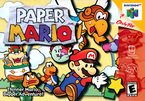 Nintendo 64 |
The original Paper Mario, released in Japan as Mario Story and originally known as Super Mario RPG 2, was released for the Nintendo 64 in 2000/2001 to positive media reaction and commercial success. It is set in a paper-based version of the Mushroom Kingdom where as Mario is attending a party at Peach's castle, the palace is suddenly uprooted and lifted into the sky by Bowser's aerial fortress. The Koopa King invades the castle, emerges victorious over Mario, and kidnaps the princess. The story centers on Mario as he tries to reclaim the seven Star Spirits, whom Bowser and his assistant Kammy Koopa had incarcerated in playing cards in an invasion of their residence, Star Haven, during which the tyrant also stole their fabled treasure, the wish-granting Star Rod, which he had used in his defeat of Mario to make himself completely invincible.
The game was rereleased for the Wii Virtual Console in 2007, for the Wii U Virtual Console in 2015, and for Nintendo 64 - Nintendo Switch Online in 2021. |
| Paper Mario: The Thousand-Year Door | |
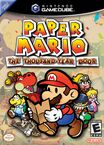 Nintendo GameCube |
Paper Mario: The Thousand-Year Door, originally released in Japan as Paper Mario RPG and tentatively known as Mario Story 2 (Japan) and Paper Mario 2 (North America and Europe), was released in 2004 for the Nintendo GameCube. Like its predecessor, it was well received by critics.
The game is set in a cursed island across an unnamed ocean in a remote area of the Mushroom Kingdom. Peach contacts Mario about a treasure map that she had bought in Rogueport, a town of thieving and notorious characters located on the aforementioned island. Once the princess goes missing, Mario takes it upon himself to search for her. Along the way, he must retrieve the seven legendary Crystal Stars, which together unlock the Thousand-Year Door, a mysterious portal fabled to lead to certain fortune. Little does he know, however, that Peach has actually been kidnapped by the Secret Society of X-Nauts, a group of cybernetic soldiers led by Sir Grodus, who are also searching for the Crystal Stars. Eventually, the X-Nauts give Peach's body to be possessed by a demon called the Shadow Queen in a bid to recover her full power, and Mario and his friends must destroy the princess's possessor in order to free her. |
| Super Paper Mario | |
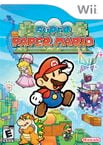 Wii |
Super Paper Mario was released for the Wii in 2007 and was the only entry to blend side-scrolling platformer gameplay with RPG gameplay. It was originally developed for the GameCube, but silently moved to its successor platform, the Wii.
Luigi, Bowser, and Peach are kidnapped by the villainous Count Bleck, who controls a book of power called the Dark Prognosticus. To fulfill what is foretold in this tome, he arranges a wedding between Peach and Bowser, and thus summons the Chaos Heart to open a black hole known as "The Void", which will eventually grow large enough to destroy the entire universe. Mario is found by the Pixl character Tippi, who transports him to the interdimensional town of Flipside, where he must travel across various dimensions to collect the eight Pure Hearts, which together can be used to banish the Chaos Heart and reverse the destruction. Mario reunites with Peach and Bowser, who agree to help Mario. Count Bleck periodically sends out his minions: the warrior O'Chunks, the immature shapeshifter Mimi, and the mysterious dimension-traveling jester Dimentio. Luigi is brainwashed into the gentleman-thief alter ego "Mr. L", who also antagonizes the heroes; but upon being defeated in battle, regains his memory and joins his brother's cause. It is gradually revealed as the game progresses that "Count Bleck" is the villainous pseudonym of an insane man named Blumiere, and Tippi is a transformed version of a human figure named Lady Timpani, who was banished to wander between dimensions by Blumiere's disdainful father when he learned of her romantic relationship with his son. Once all eight Pure Hearts have been collected, Mario and company enter Count Bleck's castle, where Bowser, Peach, and Luigi engage in one-on-one battles with Bleck's minions. Mario confronts Bleck but is unable to attack due to the Chaos Heart making him invincible; however, the other three heroes reappear, use the Pure Hearts to halt Bleck's defenses, and help Mario defeat him. Dimentio then becomes the game's true villain; decides to use the Chaos Heart to create a new universe in his own image; and fuses it, Luigi, and himself into a new entity called "Super Dimentio", whom Mario and his friends must use their combined might and the power of the Pure Hearts to defeat in order to restore every world and dimension in the universe. Like the previous two entries, this game received positive reviews and sold well. It was rereleased on the Wii U eShop in 2016. |
| Paper Mario: Sticker Star | |
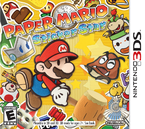 Nintendo 3DS |
Paper Mario: Sticker Star, known as Paper Mario: Super Seal in Japan, was released for the Nintendo 3DS in 2012 and incorporates the series' papercraft style into its unique gameplay mechanics. The Mushroom Kingdom welcomes the arrival of the Sticker Comet, and those who wish on it have a good chance of their wish being granted by the Royal Stickers that reside within. Mario attends the Sticker Fest, a festival held in Decalburg to accommodate the comet's arrival, and as the attendees begin to make their wishes, Bowser crashes the celebration and attempts to make his own wish by touching the comet, causing it to explode, and scattering the six Royal Stickers across the kingdom. One Royal Sticker lands on Bowser, corrupting him with its power, and the Koopa King moves to kidnap Peach and knock Mario out. After regaining consciousness, Mario encounters Kersti the sticker fairy, caretaker of the Royal Stickers, who demands that Mario help her recover them. So, they embark on their journey toward Bowser's sky castle and attempt to match his sticker power, defeat him, and get the princess back. It is the first game in the series to be released for a handheld console. |
| Paper Mario: Color Splash | |
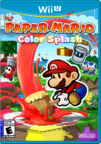 Wii U |
Paper Mario: Color Splash was released for the Wii U in 2016. Mario and Peach get a letter from Prism Island, which turns out to be a color-drained Toad, and then set sail for Port Prisma, only to find it deserted, with many spots and objects drained of color. A large metal vault appears at the bottom of the dried-out fountain, which reveals Huey, the paint can character who guards the fountain. Huey asks Mario to assist him in recovering the Big Paint Stars, the main sources of color for the entire island, from Bowser and his Koopalings. While Mario is scouting the island, Peach is kidnapped by Bowser, who had tampered with the Color Fountain to create toxic black paint, which then transformed him into the more malevolent and meaner-spirited Black Bowser. After recovering the Paint Stars, Mario and Huey infiltrate Black Bowser's Castle, where they must halt his weapons factory's operations, defeat Bowser in battle, rescue Peach, and restore peace to the island. |
| Paper Mario: The Origami King | |
 July 17, 2020 Nintendo Switch |
Paper Mario: The Origami King was released for the Nintendo Switch worldwide on July 17, 2020. The game follows the aesthetic style of its predecessor, Paper Mario: Color Splash, and follows Mario opposing an evil army of origami characters known as Folded Soldiers, ruled by the Origami King, King Olly, which have taken over the Mushroom Kingdom and kidnapped Princess Peach. He is assisted by King Olly's sister, Olivia, throughout most of his journey. They adventure to various locations in order to defeat King Olly and his Legion of Stationery, which are using streamers to constrict Peach's Castle. |
Remake[edit]
| Title | |
|---|---|
| Cover, original release, and system | Description |
| Paper Mario: The Thousand-Year Door | |
 May 23, 2024 Nintendo Switch |
A remake of the Nintendo GameCube game of the same name, set to release for Nintendo Switch in May 23, 2024. |
Crossover[edit]
| Title | |
|---|---|
| Cover, original release, and system | Synopsis |
| Mario & Luigi: Paper Jam | |
 Nintendo 3DS |
Mario & Luigi: Paper Jam, known as Mario & Luigi: Paper Jam Bros. in PAL regions, and released for the Nintendo 3DS in 2015, is a crossover between the Paper Mario games and the Mario & Luigi series. While attempting to fix a hole in Peach's castle library, Luigi trips and knocks over a mysterious book containing the Paper Mario world, causing the paper-thin residents within it to spread across the Mushroom Kingdom. Afterwards, Bowser combines his evil army with that of his paper counterpart, and they kidnap Peach and her paper version. Mario and Luigi must now team up with Mario's paper counterpart to set everything right, defeat both Bowsers, and bring all the paper people back into the book.
Paper Jam can be considered the aftermath of Sticker Star and Mario & Luigi: Dream Team, resulting in the sprite-based residents of the Super Mario universe meeting their paper-thin counterparts from the Paper Mario universe. Paper Mario can use his paper thin body to perform his own unique actions that will help the brothers, or make copies of himself during battle to deal extra damage or attack multiple enemies at once. Mario and other characters also gain their own papercraft versions which can be used in certain sections of the game to defeat papercraft enemies. |
Miscellaneous[edit]
- A Flash game called Super Paper Mario Memory Match was released in 2007 to promote Super Paper Mario.
- In 2016, browser games were released on the Play Nintendo website called Paper Mario: Color Splash Trivia Quiz and Paper Mario: Color Splash Personality Test.
Characters[edit]
Major protagonists[edit]
| Character | ||
|---|---|---|
| Image | Brief biography | First Paper Mario appearance |
| Mario | ||
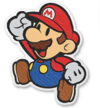
|
Mario is the eponymous main character of the series, often accompanied by different partners throughout each game. As in most games in the Super Mario franchise, Mario is a silent protagonist, thought he mostly communicates by nodding and hand gestures. In Paper Mario: The Thousand-Year Door and Super Paper Mario, Mario also grunts and has very little quotes. | |
| Luigi | ||
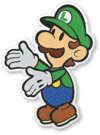
|
Luigi often acts as an NPC. In Paper Mario, he stays at the Mario Bros.' House, and in Paper Mario: The Thousand-Year Door, he goes on his own adventure off-screen which Mario can learn about if he talks to him. Luigi takes on a more major role in Super Paper Mario, where for most of the game he is brainwashed and turned into Mr. L to work for Count Bleck, but after Chapter 6 he is turned back to normal and becomes one of the main playable characters, having his characteristic higher jump height and lower ground traction in addition to being able to do a super jump, which can be used to jump higher or deal double damage to enemies directly above him. In Paper Mario: Sticker Star and Paper Mario: Color Splash, Luigi hides in certain spots in some levels and can be pulled out by using Paperize and Cutout respectively. In the latter, he also helps Mario reach Black Bowser's Castle. In Paper Mario: The Origami King, Luigi's role in the story is to find the Key to Peach's Castle; however, he usually ends up finding different keys that he mistakes for the right key instead, although these keys are still helpful to Mario. | |
| Princess Peach | ||
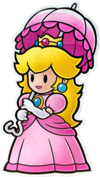
|
Princess Peach is usually the damsel in distress in most of the installments. In Paper Mario and Paper Mario: The Thousand-Year Door, the player briefly takes control of her while she tries to find out more about the plans of her kidnappers and give this information to Mario. In Super Paper Mario, she is a more major playable character available after Chapter 1. She can duck under her parasol to become invulnerable to enemy attacks and can also use her parasol to float a long distance in the air. In Paper Mario: Color Splash before she is kidnapped (which happens after obtaining the first Big Paint Star), she can heal Mario fully whenever he speaks with her. In Paper Mario: The Origami King, Peach is turned into Origami and brainwashed by King Olly to do his bidding. | |
| Tippi | ||

|
Tippi is Mario's primary partner in Super Paper Mario. She was originally a human called Lady Timpani and the lover of Lord Blumiere until Blumiere's father banished her. Merlon found her in Flipside and, to save her life, turned her into a Pixl. Tippi brings Mario to Flipside after The Void was opened and joined him for the adventure. Whenever the player points their Wii Remote at the screen, Tippi can Tattle enemies and reveal hidden objects & doorways. | |
| Kersti | ||
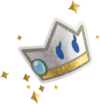
|
Kersti is Mario's partner in Paper Mario: Sticker Star. She arrived at the Mushroom Kingdom on the Sticker Comet, but after Bowser stole the Royal Stickers, she was stuck to a sign when she and Mario first met. She allows Mario to use the Paperize move in the field, and in battle, allows him to use the Battle Spin, which lets Mario use multiple stickers in one turn. | |
| Huey | ||
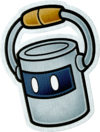
|
Huey is Mario's partner in Paper Mario: Color Splash. He resides under the Prisma Fountain in Port Prisma, and first meets Mario after uncovering him. Huey allows Mario to use the Cutout and Paint Hammer moves in the field, and in battle allows Mario to paint his Battle Cards. For the latter ability though, Huey had to be wrung out from his 3D form into his 2D form. | |
| Olivia | ||
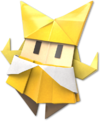
|
Olivia is Mario's primary partner in Paper Mario: The Origami King, and the younger sister of King Olly whose nefarious plan she tries to stop. She can transform into past Vellumental bosses when on certain magic circles, and gives Mario usage of the 1,000-Fold Arms. | |
Partners[edit]
| Character | ||
|---|---|---|
| Image | Brief biography | First Paper Mario appearance |
| Goombario | ||
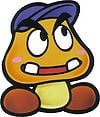
|
Goombario is Mario's first partner in Paper Mario. He was named after Mario himself, and has admired him for a long time. He joins Mario at the beginning of the adventure right when Mario leaves Goombario's house in Goomba Village. In the field, he can give a description of the current area or of anyone. In battle, Goombario can use his Headbonk move to damage an enemy, or he can use Tattle to reveal enemy stats and display their HP permanently. When Super-Ranked, he can Charge which boosts his power for his next attack by 2. When Ultra-Ranked, he can Multibonk where he attacks an enemy until the player misses an action command. | |
| Kooper | ||
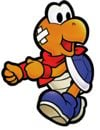
|
Kooper is Mario's second partner in Paper Mario. Kolorado is his idol, and has dreamed of adventuring with him. He joins Mario after retrieving his shell from Fuzzies in Koopa Village. In the field, he can be used to hit switches or collect items from far away or deal a First Strike to enemies. In battle, he can use Shell Toss to attack the enemy at the front or use Power Shell to attack all enemies on the ground. When Super-Ranked, he can use Dizzy Shell to make enemies dizzy. When Ultra-Ranked, he can use Fire Shell to deal fire-damage to all enemies on the ground. | |
| Bombette | ||
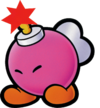
|
Bombette is Mario's third partner in Paper Mario. She was initially one of many Bob-ombs working at Koopa Bros. Fortress until the Koopa Bros. imprisoned her and most of the other Bob-ombs. She joins Mario after he helps her escape her jail cell. In the field, she can blow up cracks in walls or deal a First Strike to an enemy. In battle, she can Body Slam into the enemy at the front or Bomb it. When Super-Ranked, she can use Power Bomb to damage all enemies on the ground. When Ultra-Ranked, she can use Mega Bomb to damage all enemies. | |
| Parakarry | ||
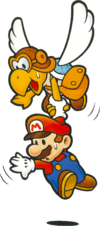
|
Parakarry is Mario's fourth partner in Paper Mario. In this game and in Paper Mario: The Thousand-Year Door, he delivers a letter to Mario which starts off the adventure. He lost a lot of letters throughout the Mushroom Kingdom, and joins Mario after finding his lost letters on Mt. Rugged. In the field, Parakarry can deliver letters to recipients if Mario talks to them while he is active, and he can carry Mario over large gaps. In battle, he can use Sky Dive or Shell Shot to damage one enemy. When Super-Ranked, he can use Air Lift to carry an enemy out of the battle. When Ultra-Ranked, he can use Air Raid to damage all enemies. | |
| Lady Bow | ||
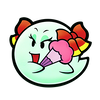
|
Lady Bow is Mario's fifth partner in Paper Mario. She is the master of Boo's Mansion, and after Tubba Blubba began eating Boos, Bootler brought Mario to her where she offers to set free the Star Spirit Skolar (who escaped from Tubba Blubba's Castle) in exchange of defeating Tubba Blubba. She joins Mario to help him do this, then decides to stick with him for the rest of the adventure. In the field, she can make Mario transparent to avoid detection from enemies or pass through obstacles while on a moving surface (e.g a Lava waterfall in Bowser's Castle). In battle, she can Smack one enemy or use Outta Sight to make herself and Mario immune to the next enemy turn, although this will also skip Bow's next turn. When Super-Ranked, she can use Spook to scare enemies away. When Ultra-Ranked, she can Fan Smack an enemy. | |
| Watt | ||

|
Watt is Mario's sixth partner in Paper Mario. She was trapped in a lantern held by a Big Lantern Ghost in Shy Guy's Toy Box, and joins Mario after he rescues her. In the field, she can light up dark areas and reveal hidden blocks. In battle, she can use Electro Dash to attack one enemy and pierces its defense, or use Power Shock to paralyze one enemy. When Super-Ranked, she can use Turbo Charge to boost Mario's attack power. When Ultra-Ranked, she can use Mega Shock to paralyze all enemies. | |
| Sushie | ||

|
Sushie is Mario's seventh partner in Paper Mario. She is a babysitter for five Yoshi children on Lavalava Island. After they went missing in Jade Jungle, she joined Mario to find them and then decided to stick with him. In the field, she can ferry Mario across water at certain docks, and can dive briefly. In battle, she can Belly Flop or Squirt one enemy, the latter dealing Water damage. When Super-Ranked, she can use Water Block to boost Mario's defense. When Ultra-Ranked, she can use Tidal Wave to deal Water damage to all enemies. | |
| Lakilester | ||
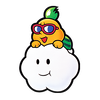
|
Lakilester is Mario's eighth and final partner in Paper Mario. He was a minion of Huff N. Puff and picks a fight with Mario under orders from him. After losing the fight, Lakilester decides to betray Huff N. Puff and joins Mario's side. In the field, Mario can ride on Lakilester's cloud to move at a faster speed than normal, and can hover across spikes and lava. In battle, he can use Spiny Flip to throw a Spiny Egg at an enemy, or use Spiny Surge to throw a bunch of Spiny Eggs at all enemies. When Super-Ranked, he can use Cloud Nine to make enemy attacks sometimes miss Mario. When Ultra-Ranked, he can use Hurricane to blow all enemies away. | |
| Goombella | ||
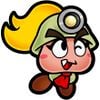
|
Goombella is Mario's first partner in Paper Mario: The Thousand-Year Door. She went to Rogueport to learn about the Legendary Treasure under the city, and joins Mario after he rescues her from Lord Crump and some X-Nauts. She behaves exactly like Goombario in the field and in battle, except she learns Multibonk when Super-Ranked, and when Ultra-Ranked, she can use Rally Wink which lets Mario use another action. | |
| Koops | ||

|
Koops is Mario's second partner in Paper Mario: The Thousand-Year Door. Ten years before the events of the game, his father went to fight Hooktail but was believed to have died. Wanting to avenge his father, Koops went with Mario to Hooktail Castle. After defeating Hooktail and realizing his father was alive, Koops decided to continue travelling with Mario. He behaves exactly like Kooper in the field and in battle, except his shell toss in the field can be held down while Mario can move around. When Super-Ranked, he can protect Mario in a Shell Shield. When Ultra-Ranked, he can use Shell Slam to attack all enemies on the ground and pierce their defense. | |
| Flurrie | ||

|
Flurrie is Mario's third partner in Paper Mario: The Thousand-Year Door. She was a retired actress who lives in Boggly Woods and was planning a stage comeback. She joins Mario after he finds her Necklace for her. In the field, she can exhale to reveal hidden things and stop enemies in their tracks. In battle, she can Body Slam an enemy from above or use Gale Force to blow all enemies away. When Super-Ranked, she can use Lip Lock to damage an enemy and heal her own HP. When Ultra-Ranked, she can use Dodgy Fog to make enemy attacks sometimes miss Mario. | |
| Mini-Yoshi | ||

|
Mini-Yoshi is Mario's fourth partner in Paper Mario: The Thousand-Year Door. He hatched from his egg in Glitzville while Mario was fighting in the Glitz Pit, and joined Mario not long afterwards. The player gives him a name beforehand. In the field, Mario can ride him to move at a faster pace and hover over large gaps. In battle, he can Ground Pound an enemy or can Gulp the enemy at the front and spit it at the enemy behind it damaging them both (this is the only way to defeat the Armored Harriers). When Super-Ranked, he can throw Mini-Eggs at enemies to shrink them. When Ultra-Ranked, he can summon a Stampede of Yoshis to attack all enemies. | |
| Vivian | ||
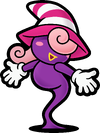
|
Vivian is Mario's fifth partner in Paper Mario: The Thousand-Year Door. She was a member of the Shadow Sirens and fought alongside them against Mario in Boggly Woods. Later, after Mario's identity was stolen by Doopliss, Vivian felt Beldam mistreated her too much and helped Mario recover his identity and joined his party afterwards. In the field, she can hide herself and Mario in the shadows, which has the same mechanics as Bow's field ability. In battle, she can use Shade Fist to punch an enemy and set it on fire, and she can use Veil which works like Bow's Outta Sight move. When Super-Ranked, she can use Fiery Jinx to damage all enemies, piercing their defense and setting them on fire. When Ultra-Ranked, she can use Infatuate to confuse all enemies. | |
| Admiral Bobbery | ||
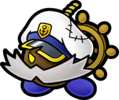
|
Admiral Bobbery is Mario's sixth and final partner in Paper Mario: The Thousand-Year Door. He was a retired sailor who quit after his wife Scarlette passed away due to blaming himself for her death. However, when Mario gave him a letter from Scarlette, he decided to help Mario reach Keelhaul Key. He joins Mario's party after saving him from Embers and giving him Chuckola Cola. In the field, he behaves like Bombette except he can be thrown onto ledges and over short walls. In battle, he can Bomb like Bombette and can use Bomb Squad to throw three bombs that explode on the next turn. When Super-Ranked, he can use Hold Fast to damage enemies that attack him directly. When Ultra-Ranked, he can use Bob-ombast to damage all enemies. | |
| Ms. Mowz | ||

|
Ms. Mowz is the only optional partner in Paper Mario: The Thousand-Year Door. She is initially seen robbing storerooms in Hooktail Castle, The Great Tree, and the Glitz Pit for Badges. After chapter 4, Mario can choose to solve her trouble, after which she will join Mario. In the field, she can sniff to see if there are any items nearby. In battle she can use Love Slap to damage the enemy at the front, piercing its defense, or she can use Kiss Thief to steal an item or badge from the enemy at the front. When Super-Ranked, she can use Tease to make enemies dizzy. When Ultra-Ranked, she can Smooch Mario to restore his HP. | |
| Thoreau | ||

|
Thoreau is the first Pixl in Super Paper Mario. He is found in the basement of a building in Yold Town. He can grab objects or enemies for Mario to throw. | |
| Boomer | ||

|
Boomer is the second Pixl in Super Paper Mario. He is found in an underground area in Gloam Valley. He can blow up cracks in walls, destroy brick blocks or deal double-damage to enemies. | |
| Slim | ||

|
Slim is the third Pixl in Super Paper Mario. He is found in Merlee's Mansion after Mimi enslaves Mario. He can make Mario thin to pass through tight areas while in 3D or if Mario stands still, he will be invisible and can pass through obstacles while on a moving platform. | |
| Thudley | ||
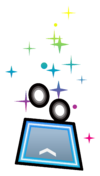
|
Thudley is the fourth Pixl in Super Paper Mario. He is found in The Tile Pool. He allows Mario to perform a Ground Pound which can activate certain switches or deal double-damage to enemies. | |
| Carrie | ||

|
Carrie is the fifth Pixl in Super Paper Mario. She is found in a cage in the basement of Fort Francis. She can carry Mario, moving at a faster pace and can go over spikes. | |
| Fleep | ||
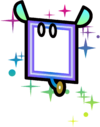
|
Fleep is the sixth Pixl in Super Paper Mario. He is found in an outhouse on Planet Blobule, and comes out once Mario gives him the Ancient Clue to use as toilet paper. He can flip a part of the background, if used on a sparkling rift it will reveal an item or switch. This ability can also stun enemies. | |
| Cudge | ||

|
Cudge is the seventh Pixl in Super Paper Mario. He is revealed after placing the elemental tablets in the correct spots in the Gap of Crag. He allows Mario to swing a Hammer which can destroy yellow blocks and deal double-damage to enemies. | |
| Dottie | ||

|
Dottie is the eighth and final Pixl in Super Paper Mario. She is found accompanying Gabbro in the Floro Caverns, but leaves him to join Mario. She can shrink Mario to let him go under tiny gaps and avoid detection from enemies. | |
| Barry | ||
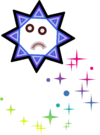
|
Barry is an optional Pixl in Super Paper Mario. He hides behind a bush in The Bitlands, and the first time he is seen, he gives Mario advice on how to reach Fort Francis. After Tippi is rescued, Barry joins Mario if he visits him again. He can briefly create a shield around Mario to damage enemies that attack him directly or deflect enemy projectiles. | |
| Dashell | ||

|
Dashell is an optional Pixl in Super Paper Mario. He is found at the bottom of the Flipside Pit of 100 Trials after defeating Wracktail. He allows Mario to run at high speed. | |
| Piccolo | ||

|
Piccolo is an optional Pixl in Super Paper Mario. She is found in an empty house in Flopside, which can be accessed after completing a trading quest starting and ending with Merlee. She can cure any status effects and make Mario's jumping & Bowser's fire breath sound effects the same as the original Super Mario Bros. She can also put the Underchomp to sleep. | |
| Tiptron | ||

|
Tiptron is a replacement of Tippi in the post-game of Super Paper Mario. She is a robotic replica of Tippi created by Francis, and can be bought from him for 999 Coins. She functions exactly the same as the real Tippi. | |
| Bob-omb | ||

|
Bob-omb, nicknamed Bobby by Olivia, is an amnesiac Bob-omb without a fuse in Paper Mario: The Origami King. He meets Mario in a cable car, and joins Mario during the blue streamer area. In battle, Bob-omb attacks one enemy using a Bomb Bump move. | |
| Professor Toad | ||
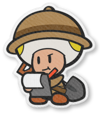
|
Professor Toad is a Toad archaeologist in Paper Mario: The Origami King who joins Mario while in the yellow streamer area. In the field, he can dig items from certain areas and translate ancient texts. In battle, he attacks up to four enemies using a Dig This move. | |
Major antagonists[edit]
| Character | ||
|---|---|---|
| Image | Brief biography | First Paper Mario appearance |
| Bowser | ||
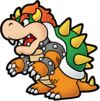
|
Bowser is the main antagonist and final boss in Paper Mario, Paper Mario: Sticker Star, and Paper Mario: Color Splash, a minor villain in Paper Mario: The Thousand-Year Door, and a deuteragonist in Super Paper Mario. In Paper Mario, Bowser steals the Star Rod from Star Haven and captures the seven Star Spirits to prevent wishes from being granted. In Paper Mario: The Thousand-Year Door, Bowser attempts to find the Crystal Stars before Mario, and he is briefly playable in intermissions after each chapter; some of these involve a Super Mario Bros.-style level. In Super Paper Mario he is a more major playable character unlocked after defeating him during chapter 3 and siding with Mario to defeat Count Bleck and save the universe. He moves slower than the other characters, but his attack power is double of everyone else's and he can breathe fire to decimate enemies or light torches. In Paper Mario: Sticker Star, Bowser breaks the Sticker Comet and scatters the Royal Stickers, one of which he wears and gains great power from. In Paper Mario: Color Splash, Bowser gets covered in and possessed by black paint and attempts to paint the whole world black. In Paper Mario: The Origami King, Bowser is no longer an antagonist and instead plays the role as a partner to Mario while in Origami Castle. | |
| Sir Grodus | ||

|
Sir Grodus is the supreme leader of the X-Nauts and the main antagonist for most of Paper Mario: The Thousand-Year Door. He sought to gather the Crystal Stars to awaken the Shadow Queen and take over the world, and kidnapped Princess Peach to use as the vessel. However, the Shadow Sirens had tricked him and his body is decimated by the Shadow Queen. | |
| Beldam | ||
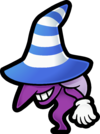
|
Beldam is the leader of the Shadow Sirens and a major antagonist in Paper Mario: The Thousand-Year Door. Throughout the whole game, she was the one plotting the revival of the Shadow Queen and achieved this by using Sir Grodus and spreading rumors about a "legendary treasure" beneath Rogueport. | |
| Shadow Queen | ||
| The Shadow Queen is the final boss in Paper Mario: The Thousand-Year Door. She is the soul of an ancient demon that destroyed the town where Rogueport is now located 1000 years ago, and was sealed away in the Palace of Shadow by four heroes. Once she is summoned from her tomb by Sir Grodus, the sky turns dark and she possesses Princess Peach. However, after a long grueling battle, Mario defeats her for good and releases Princess Peach from her control. | ||
| Count Bleck | ||
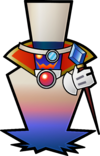
|
Count Bleck is the main antagonist in Super Paper Mario. He was initially Lord Blumiere and in love with Lady Timpani until she was banished by Blumiere's father. Blumiere took the alias of Count Bleck and attempted to use instructions from the Dark Prognosticus to put an end to all worlds; his reasoning to destroy all that took Timpani away from him. | |
| Dimentio | ||

|
Dimentio is one of Count Bleck's right-hand minions. However, throughout the course of the game, he has his own agenda to use the heroes and the Pure Hearts to overthrow Count Bleck and take control of the Chaos Heart himself and thus he is the game's final boss, in a form merged with the Chaos Heart and Mr. L called Super Dimentio. | |
| Mr. L | ||
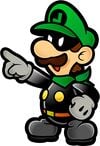
|
Mr. L is a brainwashed version of Luigi who serves Count Bleck temporarily. In Chapters 4 and 6, he uses his robotic creations to try to stop Mario, Peach, and Bowser. After his second defeat, Dimentio sends him to the Underwhere, thereby reverting his hypnosis and turning him back into Luigi. He also returns later on, when Dimentio uses a Floro Sprout to control Luigi and fuses him with the Chaos Heart to form Super Dimentio. | |
| King Olly | ||

|
King Olly, also known as the Origami King, is the main antagonist of Paper Mario: The Origami King. He turns Princess Peach and Bowser's minions into origami figures and brainwashes them into siding with him as the Folded Soldiers. He also takes over Peach's Castle by covering it in giant streamers and placing it on a mountain. | |
Supporting antagonists[edit]
| Character | ||
|---|---|---|
| Image | Brief biography | First Paper Mario appearance |
| Kammy Koopa | ||

|
Kammy Koopa is Bowser's right-hand minion in Paper Mario and Paper Mario: The Thousand-Year Door. In the former, she helped Bowser steal the Star Rod and constructed the Power Platform for the final battle. In the latter, she assisted Bowser in searching for the Crystal Stars and fights alongside him in the Palace of Shadow. | |
| Lord Crump | ||
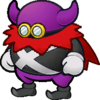
|
Lord Crump is second-in-command of the X-Naut army, and a recurring boss in Paper Mario: The Thousand-Year Door. He is the first enemy battled in the game and later fights while controlling his robot Magnus von Grapple, and eventually an upgraded version of it. Despite his high rank, Sir Grodus refers to him as his least-competent underling. | |
| O'Chunks | ||

|
O'Chunks is one of Count Bleck's right-hand minions, and the most fought one throughout Super Paper Mario. He is a huge bulky warrior who is very loyal to Count Bleck and volunteered to stop Mario the moment they learnt that he was opposing them. | |
| Mimi | ||
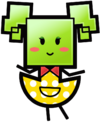
|
Mimi is one of Count Bleck's right-hand minions. She is a shape-shifter who often uses this ability to trick Mario and the other heroes into falling for her traps. Her true form is a Spider-like creature. Like O'Chunks, Mimi is very loyal to Count Bleck. | |
| Nastasia | ||
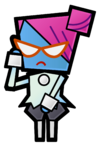
|
Nastasia is a high-ranking minion of Count Bleck, who uses her powers of hypnosis to brainwash a large amount of the Koopa Troop as well as Luigi (to create Mr. L). She was also able to force Princess Peach to say "I do" in order to help Bleck create the Chaos Heart. Carson's story, Of Bats and Men, implies she was created when Blumiere freed a bat from a trap, who later transformed into a woman and pledged loyalty to him out of love. | |
| Bowser Jr. | ||
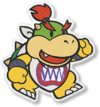
|
Bowser Jr. is the tertiary antagonist and a recurring boss in Paper Mario: Sticker Star, as well as a supporting character in Paper Mario: The Origami King. In Sticker Star, he fights Mario three times; the first and second times to steal rare stickers from him and the third to seek revenge. In The Origami King, Bowser Jr. sides with Mario while in the Green Streamer area to rescue his father from the Folded Soldiers. | |
| Kamek | ||
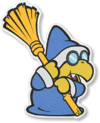
|
Kamek is the secondary antagonist in Paper Mario: Sticker Star and Paper Mario: Color Splash, and a supporting character in Paper Mario: The Origami King. In Sticker Star, he fights Mario three times; the second and third times turning all of Mario's stickers into Flip-Flop stickers. In Color Splash, in random battles he does something to mess with Mario's battle cards and fights him once towards the end of the game. In The Origami King, Kamek teams up with Mario in the Green Streamer area, and can attack enemies by firing magic shots at them. | |
Similarities between the games[edit]
- Despite their differences in genre, all games feature role-playing game elements:
- Each game includes turn-based combat, although in Super Paper Mario this is limited to the battle against the Underchomp.
- Characters have numeric stats such as Heart Points that are relevant in battle.
- The main playable characters can increase their stats. The first three games award experience points for defeating enemies in battle. In subsequent games, Mario can increase his stats with MAX UP Hearts (which increase both maximum HP and First Strike power) and Hammer Scraps.
- Each game includes status effects. In Paper Mario: The Origami King, only certain bosses apply status effects.
- Partners contribute to battle and puzzle-solving in some way, and speak on Mario's behalf. The first three games have multiple partners that can be controlled to use additional moves in combat. In later games, there are still characters that temporarily follow Mario on the field, evocative of partners. In Paper Mario: The Origami King, some of these characters have field abilities and automatically use moves to help in battle.
- Each game fleshes out its world by including towns and members of enemy species with dialogue.
- In each game, Mario can use a hammer. This is least prominent in Super Paper Mario, where Cudge does not appear until Chapter 5.
- Each game has at least one game show event:
- In Paper Mario, there is the 64th Trivia Quiz-Off and Chuck Quizmo's quizzes.
- In Paper Mario: The Thousand-Year Door, there are the 65th Super Fun Quirk Quiz and 66th Annual Quirk Quiz.
- In Super Paper Mario, there is the "That's My Merlee!" show.
- In Paper Mario: Sticker Star, there is Snifit or Whiffit.
- In Paper Mario: Color Splash, there is Snifit or Whiffit Seabed Edition.
- In Paper Mario: The Origami King, there is Shy Guys Finish Last.
- Each game has an arrangement of the Invincibility Theme. In Paper Mario, it starts playing when Mario runs around a certain Candy Cane in Pleasant Path. In Paper Mario: The Thousand-Year Door, when playing the Bowser segments, if the player collects enough Meat in a level, Bowser grows huge and the theme plays. In Super Paper Mario, when the player obtains a Mega Star, the theme plays. In Paper Mario: Sticker Star, Paper Mario: Color Splash and Paper Mario: The Origami King, the theme plays when the player grabs a Star.
- The plot of the first five games involves collecting powerful beings based on simple shapes, usually stars. In the first three games, the final boss is invincible at first, and the stars or hearts collected make them vulnerable to damage.
- Bowser is fought in all of the first five games, even when he is a side character (in Paper Mario: The Thousand-Year Door) or ally (in Super Paper Mario).
- Between chapters in the first five games, there are intermissions or flashbacks focusing on other characters.
- The bridges that mark loading zones use the same design until Paper Mario: The Origami King, aside from Super Paper Mario which instead uses doors.
- Each game after the first introduces gameplay mechanics based on the paper art style:
- Paper Mario: The Thousand-Year Door introduces the "curses" granted by the black chest: Plane Mode, Paper Mode, Tube Mode, and Boat Mode.
- Super Paper Mario introduces the Flip ability, which plays off of the world itself being presented as flat.
- Paper Mario: Sticker Star introduces the Paperize ability and the use of stickers in combat.
- Paper Mario: Color Splash introduces Battle Cards that are used to perform moves in combat.
- Paper Mario: The Origami King introduces the 1,000-Fold Arms ability.
- In Western languages, all games after the first use the font Pop Joy.
- There are item upgrade systems in the first four games. The first three feature cooking. Paper Mario: Sticker Star has special paperization spots that upgrade inserted stickers.
- From Super Paper Mario onwards, the main partner specific to each game ultimately sacrifices themself to destroy the main threat wielded by the antagonist.
- In the first three games, there is at least one battle between Mario and one of his allies.
- In the first three games, Mario can temporarily transform into an 8-bit sprite based on those of Super Mario Bros.
- In each of the first three games, someone tells a long story, Mario falls asleep, the storyteller asks if he has been listening when he wakes up, and Mario lies by nodding. In Paper Mario and Super Paper Mario, the storyteller claims to be telling the "short version" of the story.
- In Paper Mario: The Thousand-Year Door, Super Paper Mario, and Paper Mario: Color Splash, there is an implied or minor enemy character named Johnson.
- Starting in Paper Mario: Sticker Star, there are giant photorealistic objects in each game.
Gallery[edit]
Names in other languages[edit]
| Language | Name | Meaning |
|---|---|---|
| Japanese | ペーパーマリオ Pēpā Mario |
Paper Mario |
| Chinese (simplified) | 纸片马力欧 Zhǐpiàn Mǎlì'ōu |
Paper Mario |
| Chinese (traditional) | 紙片瑪利歐[9] Zhǐpiàn Mǎlì'ōu |
Paper Mario |
Trivia[edit]
- The Paper Mario title itself is mentioned in several games. In the party at the end of Paper Mario, a Bumpty mentions that Herringway is writing a novel called "Paper Mario". The same occurs in Paper Mario: The Thousand-Year Door with the blue Toad living in a house in the Rogueport west side, who also writes a Paper Mario novel based off Mario's adventures, which gets adapted into a play.
- The novel written by Herringway is titled "Mario Story" in Japanese. In Luigi's Mansion, Neville can be seen reading a book with the same title.
References[edit]
- ^ a b Schilling, Melissa A. “Technological Leapfrogging: LESSONS FROM THE U.S. VIDEO GAME CONSOLE INDUSTRY.” California Management Review, vol. 45, no. 3, Spring 2003, pp. 6–32. EBSCOhost, doi:10.2307/41166174, https://www.researchgate.net/public...ssons_from_the_US_Video_Game_Console_Industry. Accessed March 27, 2020.
- ^ Subramanian, Annapoornima M., et al. “Capability Reconfiguration of Incumbent Firms: Nintendo in the Video Game Industry.” Technovation, vol. 31, no. 5-6, Elsevier Ltd, May 2011, pp. 228–39, doi:10.1016/j.technovation.2011.01.003, https://www.sciencedirect.com/science/article/abs/pii/S0166497211000137. Accessed 27 Mar. 2020.
- ^ a b Scullion, Chris (December 29, 2020). "Feature: The Complete History of Paper Mario". Nintendo Life. Retrieved January 31, 2021.
- ^ "Mario RPG is for the Kids". IGN. November 21, 1997.
- ^ Park, Gene (July 17, 2020). "With Origami King, the Paper Mario series leaves role-playing fans behind". The Washington Post. Retrieved February 4, 2021.
- ^ "20 Years Ago, Nintendo Transformed the RPG Genre with Paper Mario". PCMag. August 11, 2020.
- ^ http://iwataasks.nintendo.com/interviews/#/3ds/papermario/0/2
- ^ https://www.videogameschronicle.com/features/interviews/paper-mario-origami-king/
- ^ 敵人是摺紙!?《紙片瑪利歐》系列最新作Nintendo Switch《紙片瑪利歐:摺紙國王》將於7月17日發售! Nintendo. Retrieved May 18, 2020.
